They are Gnats or more accurately T38a Talon the Northrop license made copy. 🧐These remind me of the Jets used in the movie Hot Shots.
You are using an out of date browser. It may not display this or other websites correctly.
You should upgrade or use an alternative browser.
You should upgrade or use an alternative browser.
Alternate Aircraft of Nations
- Thread starter Count of Crisco
- Start date
That was 'cause they used Gnat T.1s in that movie...These remind me of the Jets used in the movie Hot Shots.
Nope. A few hundred pounds heavier with a few hundred pounds more thrust...Cant you give an overview of the Gnat 2 specifications?
Fairey Gannet AEW 31, 814 Squadron, RAN FAA, HMAS Eagle
When the Australian Government decided it was time to replace their Majestic Class Carrier, HMAS Sydney in 1960, after considerable deliberation it was decided that upgrading the Sydney with a angled deck and all the gubbins required to operate jet aircraft was not possible. It was decided that it would be cheaper in the long run to go larger and purchase a more modern carrier with a longer life. Looking around, they turned first to the Royal Navy. It was now 1965. the Royal Navy was in the midst of deciding whether to finish upgrading HMS Eagle.
The Admiralty had originally planned to give Eagle a complete rebuild on the lines of HMS Victorious, but due to high costs, plans to fit new geared steam turbines and a stretched hull were abandoned. Eagle was instead given a more austere but extensive modernisation that provided greater radar and processing capability than the systems fitted to Victorious. The changes included major improvements to the accommodation, including the installation of air conditioning. The island was completely rebuilt and a 3D Type 984 radar was installed, with processing capacity to track and rank 100 targets, twice the capability of the early 984 system fitted to Hermes and Victorious. The flight deck was modified and included a new 2½ inch armoured deck with a full 8.5 degree angle, two new steam catapults (BS5s, 151 ft (46 m) stroke on the port side forward and 199 ft (61 m) stroke in the waist) were fitted as well as new arrester gear (DAX I) and mirror sights. As well as an overhaul of the DC electrical systems, AC generators were also fitted to give additional power.
It was decided that Eagle would have her anti-aircraft guns removed and replaced by the Seacat missile system, though her aft four 4.5 inch gun turrets were retained, and all of her original machinery and equipment would be fully overhauled.
In 1959 Eagle entered Devonport Dockyard to begin this extensive refit, and by May 1964 it was complete. Standard displacement had increased to around 44,100 tons (full load displacement was 54,100 tons) and Eagle was now the largest aircraft carrier in the Royal Navy. Total cost of the refit was £31 million. The refit was intended to extend her operational life for another 10 years, and she now operated Blackburn Buccaneer, de Havilland Sea Vixen, Supermarine Scimitar and Fairey Gannet aircraft, but water-cooled jet blast deflectors (needed to operate the RN Phantom fighters) were not fitted, and therefore the full potential of the ship was not realized.
As a consequence of the British Government’s decision to cut costs, it was decided that Eagle should be retired and become a spares source for HMS Ark Royal. The Royal Australian Navy wished to both move up and keep a two carrier force in being. HMS Eagle seemed to be the ideal carrier for the RAN’s needs. The Royal Navy agreed to the sale and as part of the sale, it was offered that the ship would be refitted, with water-cooled jet blast deflectors and improved arrestor systems and radar systems.
So, in early 1966 Eagle was refitted at Devonport once more and was fitted with a single DAX II arrestor wire (no.3, her other wires were DAX I). She also had bridal catchers fitted to her catapults. Finally, she also had an improved Type 985 3-d radar and improved accommodation and air conditioning systems installed. She was recommissioned in 1968 as HMAS Eagle.
In the end, the water-cooled jet blast deflectors were not needed as the RAN never operated F-4 Phantoms. It had decided in 1966 to instead standardise on A-4 Skyhawks and F-8 Crusaders. When she entered service with the RAN she carried 18 A-4 Skyhawks, 14 F-8 Crusaders, 4 Gannet AEWs, 6 Sea King ASW helicopters and 2 Wessex SAR helicopters.
As part of the deal with the British, the RAN received also Fairey Gannet AEW aircraft. Operated by 814 Squadron from HMAS Eagle and RAN Naval Air Station Nowra (HMAS Albatross), the Gannet AEW added a new capability to the RAN and allowed it to better control the battle space over the carriers, providing early warning of approaching aircraft.

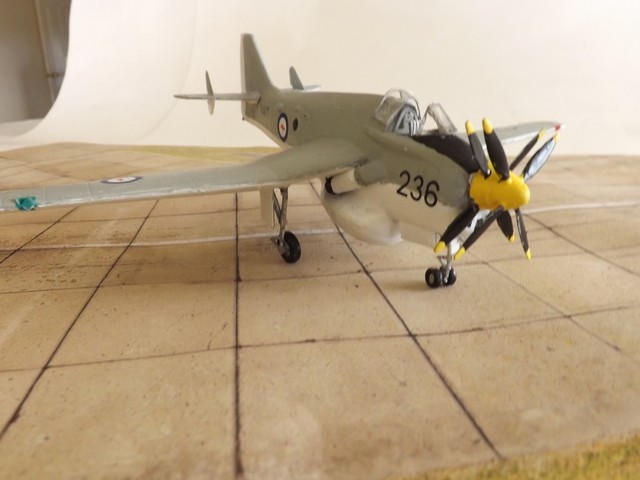
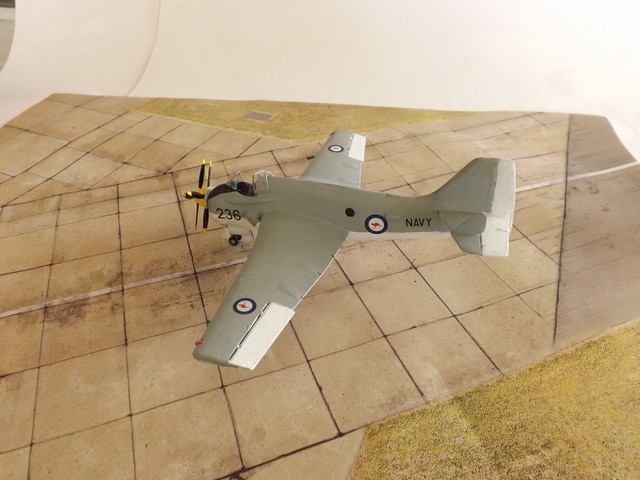
The Model
The model is a mix of a Revell Gannet T.5 wings and tail and an Airmodel Gannet AEW vacuform. She was painted with a hairy stick using Tamiya paints. The decals came from an Xtradecal Gannet set.
When the Australian Government decided it was time to replace their Majestic Class Carrier, HMAS Sydney in 1960, after considerable deliberation it was decided that upgrading the Sydney with a angled deck and all the gubbins required to operate jet aircraft was not possible. It was decided that it would be cheaper in the long run to go larger and purchase a more modern carrier with a longer life. Looking around, they turned first to the Royal Navy. It was now 1965. the Royal Navy was in the midst of deciding whether to finish upgrading HMS Eagle.
The Admiralty had originally planned to give Eagle a complete rebuild on the lines of HMS Victorious, but due to high costs, plans to fit new geared steam turbines and a stretched hull were abandoned. Eagle was instead given a more austere but extensive modernisation that provided greater radar and processing capability than the systems fitted to Victorious. The changes included major improvements to the accommodation, including the installation of air conditioning. The island was completely rebuilt and a 3D Type 984 radar was installed, with processing capacity to track and rank 100 targets, twice the capability of the early 984 system fitted to Hermes and Victorious. The flight deck was modified and included a new 2½ inch armoured deck with a full 8.5 degree angle, two new steam catapults (BS5s, 151 ft (46 m) stroke on the port side forward and 199 ft (61 m) stroke in the waist) were fitted as well as new arrester gear (DAX I) and mirror sights. As well as an overhaul of the DC electrical systems, AC generators were also fitted to give additional power.
It was decided that Eagle would have her anti-aircraft guns removed and replaced by the Seacat missile system, though her aft four 4.5 inch gun turrets were retained, and all of her original machinery and equipment would be fully overhauled.
In 1959 Eagle entered Devonport Dockyard to begin this extensive refit, and by May 1964 it was complete. Standard displacement had increased to around 44,100 tons (full load displacement was 54,100 tons) and Eagle was now the largest aircraft carrier in the Royal Navy. Total cost of the refit was £31 million. The refit was intended to extend her operational life for another 10 years, and she now operated Blackburn Buccaneer, de Havilland Sea Vixen, Supermarine Scimitar and Fairey Gannet aircraft, but water-cooled jet blast deflectors (needed to operate the RN Phantom fighters) were not fitted, and therefore the full potential of the ship was not realized.
As a consequence of the British Government’s decision to cut costs, it was decided that Eagle should be retired and become a spares source for HMS Ark Royal. The Royal Australian Navy wished to both move up and keep a two carrier force in being. HMS Eagle seemed to be the ideal carrier for the RAN’s needs. The Royal Navy agreed to the sale and as part of the sale, it was offered that the ship would be refitted, with water-cooled jet blast deflectors and improved arrestor systems and radar systems.
So, in early 1966 Eagle was refitted at Devonport once more and was fitted with a single DAX II arrestor wire (no.3, her other wires were DAX I). She also had bridal catchers fitted to her catapults. Finally, she also had an improved Type 985 3-d radar and improved accommodation and air conditioning systems installed. She was recommissioned in 1968 as HMAS Eagle.
In the end, the water-cooled jet blast deflectors were not needed as the RAN never operated F-4 Phantoms. It had decided in 1966 to instead standardise on A-4 Skyhawks and F-8 Crusaders. When she entered service with the RAN she carried 18 A-4 Skyhawks, 14 F-8 Crusaders, 4 Gannet AEWs, 6 Sea King ASW helicopters and 2 Wessex SAR helicopters.
As part of the deal with the British, the RAN received also Fairey Gannet AEW aircraft. Operated by 814 Squadron from HMAS Eagle and RAN Naval Air Station Nowra (HMAS Albatross), the Gannet AEW added a new capability to the RAN and allowed it to better control the battle space over the carriers, providing early warning of approaching aircraft.



The Model
The model is a mix of a Revell Gannet T.5 wings and tail and an Airmodel Gannet AEW vacuform. She was painted with a hairy stick using Tamiya paints. The decals came from an Xtradecal Gannet set.
F-101, 41 Squadron RAF, 1965
As we now know, Duncan Sandys was forced to resign because of his peccadillo with the Duchess of Argyll. His replacement was John Profumo. In late 1957, Profumo handed down the much expected Defence White Paper. It promised savage cuts to an already over-extended and increasingly out of date RAF. All aircraft contracts for fighters and strike aircraft were to be cut, immediately. Instead the RAF would go over to using guided missiles. Fighters were to be replaced by long range Surface to Air missiles and strike aircraft by IRBMs (Intermediate Range Ballistic Missiles) initially and then, once developed, ICBMs (Inter-Continental Ballistic Missiles), both of which were to be situated in “silos” below ground, in the British countryside.
John Profumo had done his deed. He had saved the British tax-payers millions of pounds but at the expense of several tens of thousands of workers' jobs. Profumo, as we know was later forced to resign because of his involvement with Christine Keeler. The RAF began to “wind down”. Aircraft were not replaced, except with missiles. Within five years, the RAF was only a shadow of it's former self. British aircraft manufacturing had been devastated.
The RAF realised that whilst missiles looked good on the cover of magazines, they were not quite as useful at policing the airspace of the UK. Soviet bombers started approaching closer and closer as the numbers of fighters were retired. The scandal finally broke when a Soviet Bear bomber, allegedly “blown off course” overflew Belfast without challenge in broad daylight. London was alarmed. Washington was horrified. London urgently requested that the USAF station more fighters in the UK. Washington complied, on the understanding that the UK would either restart its aircraft manufacturing or purchase aircraft from America. It did both.
The first “emergency fighter” that the RAF received from the USAF were second-hand F-101B Voodoos. Equipped with either 4 (originally 6)× AIM-4 Falcon, or 2× AIR-2 Genie nuclear rockets, plus 2× AIM-4 Falcon, carried on a rotating missile bay door.
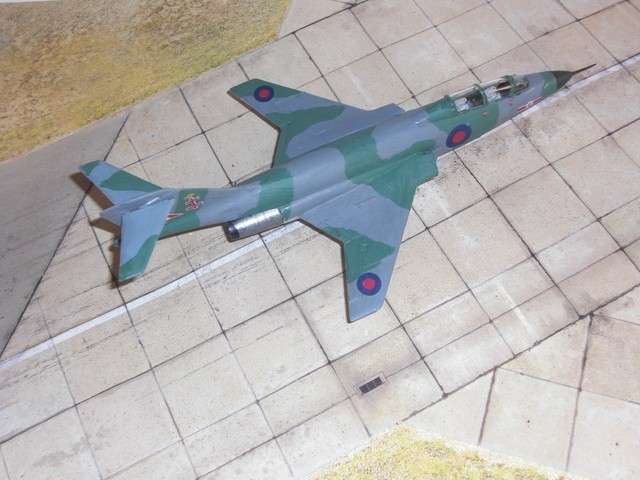
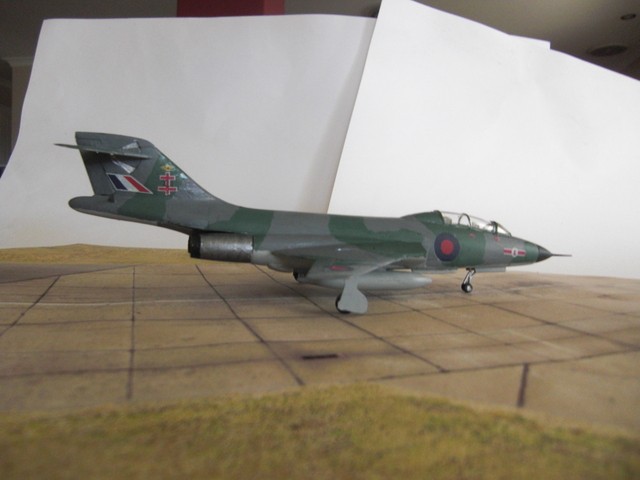
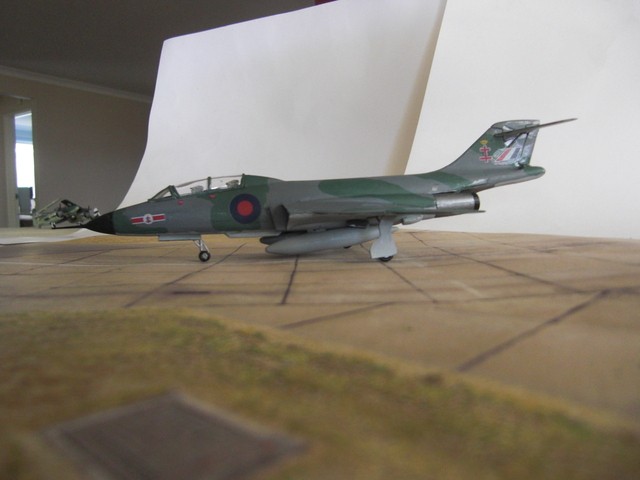
The Model
The model is an old Matchbox F-101 in 1/72 scale, finished as an aircraft from 43 Squadron RAF (which operated F-4 Phantoms). It has been brushpainted and finished with decals from the spares box.
As we now know, Duncan Sandys was forced to resign because of his peccadillo with the Duchess of Argyll. His replacement was John Profumo. In late 1957, Profumo handed down the much expected Defence White Paper. It promised savage cuts to an already over-extended and increasingly out of date RAF. All aircraft contracts for fighters and strike aircraft were to be cut, immediately. Instead the RAF would go over to using guided missiles. Fighters were to be replaced by long range Surface to Air missiles and strike aircraft by IRBMs (Intermediate Range Ballistic Missiles) initially and then, once developed, ICBMs (Inter-Continental Ballistic Missiles), both of which were to be situated in “silos” below ground, in the British countryside.
John Profumo had done his deed. He had saved the British tax-payers millions of pounds but at the expense of several tens of thousands of workers' jobs. Profumo, as we know was later forced to resign because of his involvement with Christine Keeler. The RAF began to “wind down”. Aircraft were not replaced, except with missiles. Within five years, the RAF was only a shadow of it's former self. British aircraft manufacturing had been devastated.
The RAF realised that whilst missiles looked good on the cover of magazines, they were not quite as useful at policing the airspace of the UK. Soviet bombers started approaching closer and closer as the numbers of fighters were retired. The scandal finally broke when a Soviet Bear bomber, allegedly “blown off course” overflew Belfast without challenge in broad daylight. London was alarmed. Washington was horrified. London urgently requested that the USAF station more fighters in the UK. Washington complied, on the understanding that the UK would either restart its aircraft manufacturing or purchase aircraft from America. It did both.
The first “emergency fighter” that the RAF received from the USAF were second-hand F-101B Voodoos. Equipped with either 4 (originally 6)× AIM-4 Falcon, or 2× AIR-2 Genie nuclear rockets, plus 2× AIM-4 Falcon, carried on a rotating missile bay door.



The Model
The model is an old Matchbox F-101 in 1/72 scale, finished as an aircraft from 43 Squadron RAF (which operated F-4 Phantoms). It has been brushpainted and finished with decals from the spares box.
My first reaction reading the ship was going to be discarded two years after a major rebuild was to think no one was that wasteful. But then I remembered post war RN.Fairey Gannet AEW 31, 814 Squadron, RAN FAA, HMAS Eagle
When the Australian Government decided it was time to replace their Majestic Class Carrier, HMAS Sydney in 1960, after considerable deliberation it was decided that upgrading the Sydney with a angled deck and all the gubbins required to operate jet aircraft was not possible. It was decided that it would be cheaper in the long run to go larger and purchase a more modern carrier with a longer life. Looking around, they turned first to the Royal Navy. It was now 1965. the Royal Navy was in the midst of deciding whether to finish upgrading HMS Eagle.
The Admiralty had originally planned to give Eagle a complete rebuild on the lines of HMS Victorious, but due to high costs, plans to fit new geared steam turbines and a stretched hull were abandoned. Eagle was instead given a more austere but extensive modernisation that provided greater radar and processing capability than the systems fitted to Victorious. The changes included major improvements to the accommodation, including the installation of air conditioning. The island was completely rebuilt and a 3D Type 984 radar was installed, with processing capacity to track and rank 100 targets, twice the capability of the early 984 system fitted to Hermes and Victorious. The flight deck was modified and included a new 2½ inch armoured deck with a full 8.5 degree angle, two new steam catapults (BS5s, 151 ft (46 m) stroke on the port side forward and 199 ft (61 m) stroke in the waist) were fitted as well as new arrester gear (DAX I) and mirror sights. As well as an overhaul of the DC electrical systems, AC generators were also fitted to give additional power.
It was decided that Eagle would have her anti-aircraft guns removed and replaced by the Seacat missile system, though her aft four 4.5 inch gun turrets were retained, and all of her original machinery and equipment would be fully overhauled.
In 1959 Eagle entered Devonport Dockyard to begin this extensive refit, and by May 1964 it was complete. Standard displacement had increased to around 44,100 tons (full load displacement was 54,100 tons) and Eagle was now the largest aircraft carrier in the Royal Navy. Total cost of the refit was £31 million. The refit was intended to extend her operational life for another 10 years, and she now operated Blackburn Buccaneer, de Havilland Sea Vixen, Supermarine Scimitar and Fairey Gannet aircraft, but water-cooled jet blast deflectors (needed to operate the RN Phantom fighters) were not fitted, and therefore the full potential of the ship was not realized.
As a consequence of the British Government’s decision to cut costs, it was decided that Eagle should be retired and become a spares source for HMS Ark Royal. The Royal Australian Navy wished to both move up and keep a two carrier force in being. HMS Eagle seemed to be the ideal carrier for the RAN’s needs. The Royal Navy agreed to the sale and as part of the sale, it was offered that the ship would be refitted, with water-cooled jet blast deflectors and improved arrestor systems and radar systems.
So, in early 1966 Eagle was refitted at Devonport once more and was fitted with a single DAX II arrestor wire (no.3, her other wires were DAX I). She also had bridal catchers fitted to her catapults. Finally, she also had an improved Type 985 3-d radar and improved accommodation and air conditioning systems installed. She was recommissioned in 1968 as HMAS Eagle.
In the end, the water-cooled jet blast deflectors were not needed as the RAN never operated F-4 Phantoms. It had decided in 1966 to instead standardise on A-4 Skyhawks and F-8 Crusaders. When she entered service with the RAN she carried 18 A-4 Skyhawks, 14 F-8 Crusaders, 4 Gannet AEWs, 6 Sea King ASW helicopters and 2 Wessex SAR helicopters.
As part of the deal with the British, the RAN received also Fairey Gannet AEW aircraft. Operated by 814 Squadron from HMAS Eagle and RAN Naval Air Station Nowra (HMAS Albatross), the Gannet AEW added a new capability to the RAN and allowed it to better control the battle space over the carriers, providing early warning of approaching aircraft.



The Model
The model is a mix of a Revell Gannet T.5 wings and tail and an Airmodel Gannet AEW vacuform. She was painted with a hairy stick using Tamiya paints. The decals came from an Xtradecal Gannet set.
Cool write-up and the Gannet is one of my favourite post war planes.
My reaction was there's no way Australia could man the Eagle but HMS Centaur is available, or even at pinch HMS Victorious.My first reaction reading the ship was going to be discarded two years after a major rebuild was to think no one was that wasteful. But then I remembered post war RN.
Cool write-up and the Gannet is one of my favourite post war planes.
The CA-21 Mk.25 F-82 Twin Mustang
In 1942 the Royal Australian Air Force (RAAF) was looking for a new fighter aircraft. They decided on the P-51 Mustang as their high altitude interceptor. In late 1943, an agreement between North American Aviation and the RAAF was reached. An Australian aircraft company, Commonwealth Aircraft Corporation (CAC), would build P-51Ds under license in Australia.
As part of the agreement, NAA would supply 100 P-51D Mustangs unassembled and Packard would supply some 80+ -3 Merlin engines. Delays mounted and the first CAC P-51 did not fly until April 1945. In all, 80 P-51s were completed from these parts and designated CA-17 Mk.20, A68-1 to A68-80.
As the war came to an end, the total scratch built CAC P-51s was reduced to 120 aircraft. The CAC new built P-51s were designated CA-18. Versions would be the Mark 21, Mark 22, and Mark 23.
The Merlin V-1650-7 was used in the CA-18 Mk.21 models. The CA-18 Mk.23 use the British built Rolls Royce Merlin 66 or 70 versions. The CA-18 Mk.22 were modified like the F-6D reconnaissance versions. The last CA-18 Mk.23 came off the production line in 1952.
As the war drew to a close, so far from Australian soil the RAAF felt the need for a long-range escort fighter for their B-24 Liberator and Lincoln bombers with which they were going to wage the war against Japan. Lawrence Wackett, head designer for CAC, always one step ahead of the RAAF High Command, presented to them the plans for the P-82 Twin Mustang that North American had made available to him on his visit to the United States in late 1944. This appeared to fit their requirements and because of it's commonality with the P-51 which was in production at the Commonwealth Aircraft Corporation, it would be easier to maintain and supply spares for. The major difference between the CA-21 Twin Mustangs and the USAAC P-82 Twin Mustang was the choice of engines. The Australian CA-21s stuck with the original Merlin whereas the F-82s switched, because of the expense of license fees post-war to Allisons. This made the CA-21s slightly faster and higher flying than their American counter-parts.
In April 1945 the first P-51Ds entered service with the RAAF. In July, the first CA-21, Mk.25 P-82 Twin Mustang entered service, just before the war with Japan suddenly ended with the dropping of the two Atomic bombs on Japanese cities. In the end, 100 CA-21, Mk.25 P-82 Twin Mustangs were delivered to the RAAF. Sufficient, with spares to equip two squadrons. 82 Squadron was one of the two (the other was 80 Squadron). 82 served in Japan, after the war ended as part of BCOF (British-Commonwealth Occupation Forces), while 80 effectively became it's training squadron, serving in Australia.
When the Korean War broke out in June 1950, 82 Squadron, along with 77 Squadron was on the verge of returning to Australia. Committed to the conflict within days of the North Koreans crossing the 38th Parallel, both squadrons flew successful strike missions. The extended range of the CA-21s allowed them to go far beyond that the of the shorter-ranged 77 Squadron machines, deep into North Korea (and it is rumoured, the PRC). Their utility was quickly realised and by late 1950 the CA-21s were flying interdictor and top-cover missions. When equipped with the central radar pod (the first of which were provided by the USAAC F-82 Squadrons), they were able to alert the surrounding “normal” Mustangs of the approach of North Korean jet fighters.
The model depicted is that of an 82 Squadron machine, serving out of Iwakuni, Japan in 1950. It is the only CA-21 which registered a “kill” when it shot down a Yak-9 fighter over Pusan on October 26, 1950, when flown by Flight-Lieutenant Bill McMahon.
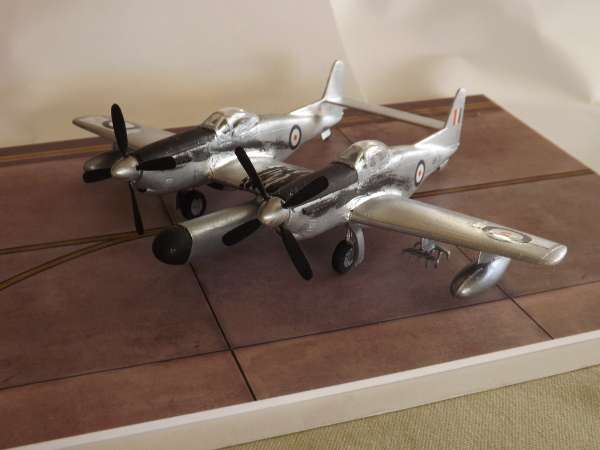
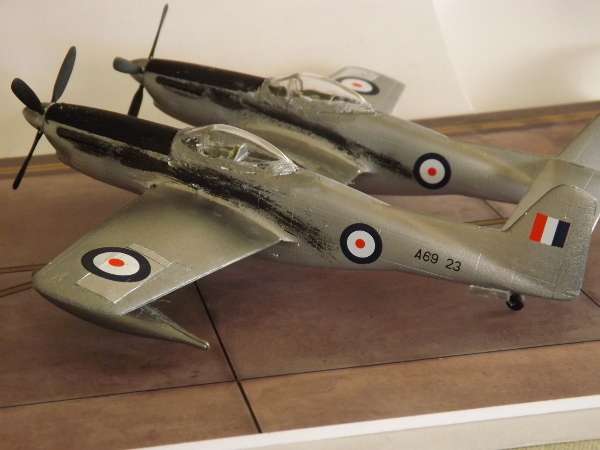
The Model
The kit used was a Special Hobby 1/72 F-82 Twin Mustang. The decals came from a post-war RAAF Mustang sheet which featured an 82 Squadron BCOF machine (It actually did exist but had left Japan by the time the Korean business broke out and only flew standard Mustangs). The story of course is complete what-if.
In 1942 the Royal Australian Air Force (RAAF) was looking for a new fighter aircraft. They decided on the P-51 Mustang as their high altitude interceptor. In late 1943, an agreement between North American Aviation and the RAAF was reached. An Australian aircraft company, Commonwealth Aircraft Corporation (CAC), would build P-51Ds under license in Australia.
As part of the agreement, NAA would supply 100 P-51D Mustangs unassembled and Packard would supply some 80+ -3 Merlin engines. Delays mounted and the first CAC P-51 did not fly until April 1945. In all, 80 P-51s were completed from these parts and designated CA-17 Mk.20, A68-1 to A68-80.
As the war came to an end, the total scratch built CAC P-51s was reduced to 120 aircraft. The CAC new built P-51s were designated CA-18. Versions would be the Mark 21, Mark 22, and Mark 23.
The Merlin V-1650-7 was used in the CA-18 Mk.21 models. The CA-18 Mk.23 use the British built Rolls Royce Merlin 66 or 70 versions. The CA-18 Mk.22 were modified like the F-6D reconnaissance versions. The last CA-18 Mk.23 came off the production line in 1952.
As the war drew to a close, so far from Australian soil the RAAF felt the need for a long-range escort fighter for their B-24 Liberator and Lincoln bombers with which they were going to wage the war against Japan. Lawrence Wackett, head designer for CAC, always one step ahead of the RAAF High Command, presented to them the plans for the P-82 Twin Mustang that North American had made available to him on his visit to the United States in late 1944. This appeared to fit their requirements and because of it's commonality with the P-51 which was in production at the Commonwealth Aircraft Corporation, it would be easier to maintain and supply spares for. The major difference between the CA-21 Twin Mustangs and the USAAC P-82 Twin Mustang was the choice of engines. The Australian CA-21s stuck with the original Merlin whereas the F-82s switched, because of the expense of license fees post-war to Allisons. This made the CA-21s slightly faster and higher flying than their American counter-parts.
In April 1945 the first P-51Ds entered service with the RAAF. In July, the first CA-21, Mk.25 P-82 Twin Mustang entered service, just before the war with Japan suddenly ended with the dropping of the two Atomic bombs on Japanese cities. In the end, 100 CA-21, Mk.25 P-82 Twin Mustangs were delivered to the RAAF. Sufficient, with spares to equip two squadrons. 82 Squadron was one of the two (the other was 80 Squadron). 82 served in Japan, after the war ended as part of BCOF (British-Commonwealth Occupation Forces), while 80 effectively became it's training squadron, serving in Australia.
When the Korean War broke out in June 1950, 82 Squadron, along with 77 Squadron was on the verge of returning to Australia. Committed to the conflict within days of the North Koreans crossing the 38th Parallel, both squadrons flew successful strike missions. The extended range of the CA-21s allowed them to go far beyond that the of the shorter-ranged 77 Squadron machines, deep into North Korea (and it is rumoured, the PRC). Their utility was quickly realised and by late 1950 the CA-21s were flying interdictor and top-cover missions. When equipped with the central radar pod (the first of which were provided by the USAAC F-82 Squadrons), they were able to alert the surrounding “normal” Mustangs of the approach of North Korean jet fighters.
The model depicted is that of an 82 Squadron machine, serving out of Iwakuni, Japan in 1950. It is the only CA-21 which registered a “kill” when it shot down a Yak-9 fighter over Pusan on October 26, 1950, when flown by Flight-Lieutenant Bill McMahon.


The Model
The kit used was a Special Hobby 1/72 F-82 Twin Mustang. The decals came from a post-war RAAF Mustang sheet which featured an 82 Squadron BCOF machine (It actually did exist but had left Japan by the time the Korean business broke out and only flew standard Mustangs). The story of course is complete what-if.
F-86K No.234 Squadron RAF 1960
Duncan Sandys was forced to resign because of his sexual peccadillo with the Duchess of Argyll. His replacement was John Profumo. In late 1957, Profumo handed down the much expected Defence White Paper. It promised savage cuts to an already over-extended and increasingly out of date RAF. All aircraft contracts for fighters and strike aircraft were to be cut, immediately. Instead the RAF would go over to using guided missiles. Fighters were to be replaced by long range Surface to Air missiles and strike aircraft by IRBMs (Intermediate Range Ballistic Missiles) initially and then, once developed, ICBMs (Inter-Continental Ballistic Missiles), both of which were to be situated in “silos” below ground, in the British countryside.
John Profumo had done his deed. He had saved the British tax-payers millions of pounds but at the expense of several tens of thousands of workers' jobs. Profumo, as we know was later forced to resign because of his involvement with Christine Keeler. The RAF began to “wind down”. Aircraft were not replaced, except with missiles. Within five years, the RAF was only a shadow of it's former self. British aircraft manufacturing had been devastated.
The RAF realised that whilst missiles looked good on the cover of magazines, they were not quite as useful at policing the airspace of the UK. Soviet bombers started approaching closer and closer as the numbers of fighters were retired. The scandal finally broke when a Soviet Bear bomber, allegedly “blown off course” overflew Belfast without challenge in broad daylight. London was alarmed. Washington was horrified. London urgently requested that the USAF station more fighters in the UK. Washington complied, on the understanding that the UK would either restart its aircraft manufacturing or purchase aircraft from America. It did both. In the meantime, it accepted US Military Aid and purchased several squadrons of F-86K Fighters.
The F-86, the RAF was already familiar with, having used the earlier F-86E built by Canadair. The F-86K was the European version of the F-86D “Dog” Sabre. The F-86K mounted four 20mm cannon, instead of the “Dog” Sabres unguided rockets. Mounting a large AN/APG-36 all-weather radar fitted in a radome in the nose, above the intake, it was able to detect it's targets at night or in bad weather. The RAF however dislike there being only a single pilot onboard to operate the aircraft, the radar and the guns, preferring two crew for such a mission. However, they were forced to accept the F-86K as built.
No.234 Squadron was a veteran operator of the F-86E when it was first taken into service with the RAF. So, it was natural to reactivate the squadron to fly the new F-86K.
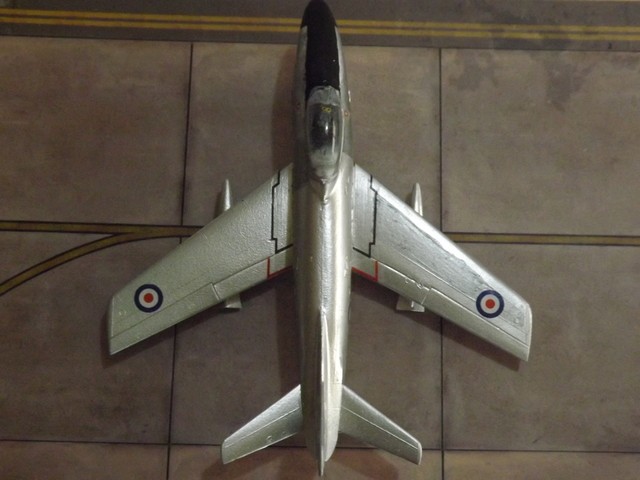
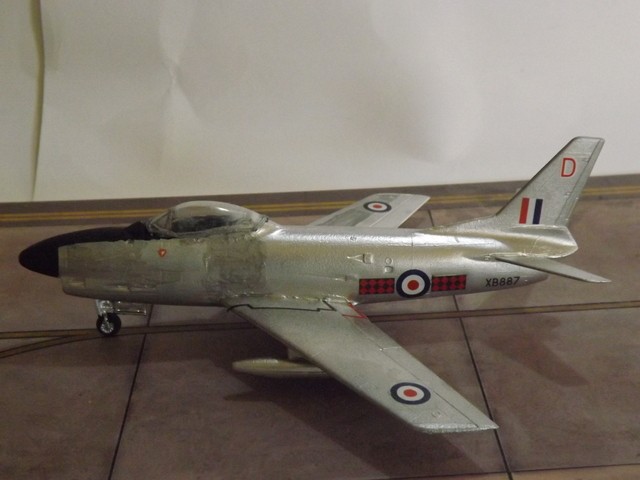
The Model
The model is a combination of the veteran Airfix F-86D fuselage and wings with an Airmodel vacuform nose conversion kit. It was painted with a rattle can and hairy stick. The markings came from Ebay.
Duncan Sandys was forced to resign because of his sexual peccadillo with the Duchess of Argyll. His replacement was John Profumo. In late 1957, Profumo handed down the much expected Defence White Paper. It promised savage cuts to an already over-extended and increasingly out of date RAF. All aircraft contracts for fighters and strike aircraft were to be cut, immediately. Instead the RAF would go over to using guided missiles. Fighters were to be replaced by long range Surface to Air missiles and strike aircraft by IRBMs (Intermediate Range Ballistic Missiles) initially and then, once developed, ICBMs (Inter-Continental Ballistic Missiles), both of which were to be situated in “silos” below ground, in the British countryside.
John Profumo had done his deed. He had saved the British tax-payers millions of pounds but at the expense of several tens of thousands of workers' jobs. Profumo, as we know was later forced to resign because of his involvement with Christine Keeler. The RAF began to “wind down”. Aircraft were not replaced, except with missiles. Within five years, the RAF was only a shadow of it's former self. British aircraft manufacturing had been devastated.
The RAF realised that whilst missiles looked good on the cover of magazines, they were not quite as useful at policing the airspace of the UK. Soviet bombers started approaching closer and closer as the numbers of fighters were retired. The scandal finally broke when a Soviet Bear bomber, allegedly “blown off course” overflew Belfast without challenge in broad daylight. London was alarmed. Washington was horrified. London urgently requested that the USAF station more fighters in the UK. Washington complied, on the understanding that the UK would either restart its aircraft manufacturing or purchase aircraft from America. It did both. In the meantime, it accepted US Military Aid and purchased several squadrons of F-86K Fighters.
The F-86, the RAF was already familiar with, having used the earlier F-86E built by Canadair. The F-86K was the European version of the F-86D “Dog” Sabre. The F-86K mounted four 20mm cannon, instead of the “Dog” Sabres unguided rockets. Mounting a large AN/APG-36 all-weather radar fitted in a radome in the nose, above the intake, it was able to detect it's targets at night or in bad weather. The RAF however dislike there being only a single pilot onboard to operate the aircraft, the radar and the guns, preferring two crew for such a mission. However, they were forced to accept the F-86K as built.
No.234 Squadron was a veteran operator of the F-86E when it was first taken into service with the RAF. So, it was natural to reactivate the squadron to fly the new F-86K.


The Model
The model is a combination of the veteran Airfix F-86D fuselage and wings with an Airmodel vacuform nose conversion kit. It was painted with a rattle can and hairy stick. The markings came from Ebay.
Saab J21B
Sweden wished to ensure its continued neutrality through a policy of armed strength during World War II but was effectively denied access to foreign weapons. Seeking to ensure that Sweden would not be on the future menu for Nazi conquests, the Swedish air force look to build it's own fighter aircraft. The original design studies began in 1939, based around the use of a Bristol Taurus engine within the centre fuselage, behind the pilot, driving a pusher propeller. The project remained dormant until 1941. In response to the need for air defence, and faced with the prospect of imported designs being unavailable due to the war, Sweden undertook an indigenous rearmament programme including an advanced fighter. The low-wing monoplane Saab 21 fighter was ultimately designed around a license-produced version of the Daimler-Benz DB 605B engine, featured innovations such as tricycle landing gear, heavy forward-firing armament, ejector seat, and a twin-boom pusher layout that later allowed the type to be modified with a turbojet engine.
The advantages of a pusher design are that the view forward is unobstructed and armament can be concentrated in the nose, while a major drawback is difficulty in escaping from the aircraft in an emergency, as the pilot could get drawn into the propeller blades. Saab deliberated between systems that would eject the pilot, or jettison the propeller or the engine, via a system of explosive bolts, and eventually installed an early ejector seat developed by Bofors for the purpose and tested in 1943.
In 1947, the aircraft was redesigned making use of a Rolls Royce Griffon engine with over 50% airframe, tailplane and wing changes, acquiring the new designation Saab J 21B. In addition, the upper rear fuselage was cut down and a bubble canopy, styled on the P-51D Mustang was put in place, affording the pilot much improved visibility to the rear quarter. Armed with three 20mm cannon in the nose and four .50cal HMGs (two in each wing), the aircraft was fast and well armed.
Operational history
The first of three J 21 prototypes flew on 30 July 1943 flown by SAAB test pilot Claes Smith. During the takeoff, the wrong flap setting resulted in the prototype running into a fence at the end of the runway, damaging one of the landing gears. The subsequent test flight ended with a successful landing on the undamaged undercarriage units.
A total of 54 J 21A-1 fighters constructed at the main plant in Trollhättan were delivered from December 1945, followed by 124 and 119 examples respectively of the J 21A-2 with revised armament and the J 21A-3 fighter-bomber. Utilised mainly in the bomber role, the limitation of the design led to a proposed front-engine replacement, the J 23. An evaluation of the two designs led to the decision to retain the J 21 series but to consider the modification of the airframe to accommodate either a Griffon or a jet engine. While production line J 21A series aircraft were first selected for conversion, the initial piston-engine version continued in production in five series "batches" that were completed in 1948–49. In service use, the J 21 was phased out after 1954. The J 21B was not adopted, the Goblin jet powered J 21R was used instead.
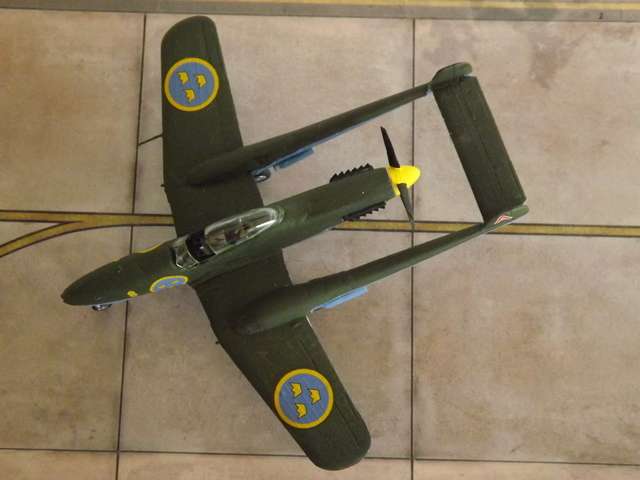
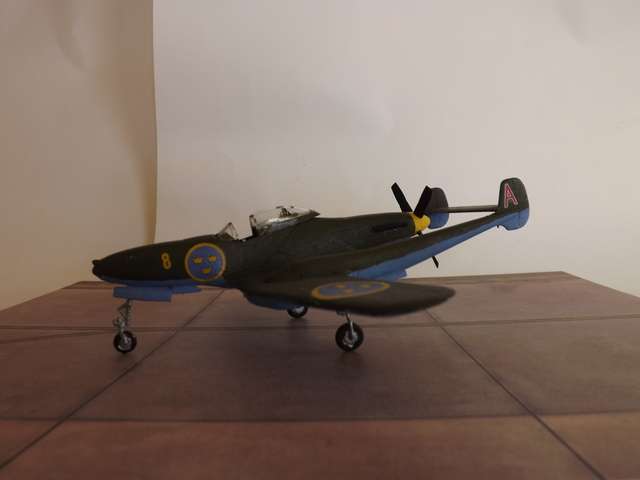
The Model
The model combines elements of the Heller J21A and the Airfix P-51D kits. I initially just wanted to cut down the J21A fuselage and use a P-51D bubble canopy. However, after a little experimentation I decided it was easier to use the nose of the P-51D as it carried a Merlin engine in it. Then I decided that the underfuselage scoop would be needed and so that came off the P-51D fuselage. After a fair amount of PSR the two mated quite well. Then I realised the booms needed extending which was accomplished with some square tubing. Then the propeller from the P-51 had to be shortened to fit between the booms. The end result is one that looks pleasing to the eye, I think.
Sweden wished to ensure its continued neutrality through a policy of armed strength during World War II but was effectively denied access to foreign weapons. Seeking to ensure that Sweden would not be on the future menu for Nazi conquests, the Swedish air force look to build it's own fighter aircraft. The original design studies began in 1939, based around the use of a Bristol Taurus engine within the centre fuselage, behind the pilot, driving a pusher propeller. The project remained dormant until 1941. In response to the need for air defence, and faced with the prospect of imported designs being unavailable due to the war, Sweden undertook an indigenous rearmament programme including an advanced fighter. The low-wing monoplane Saab 21 fighter was ultimately designed around a license-produced version of the Daimler-Benz DB 605B engine, featured innovations such as tricycle landing gear, heavy forward-firing armament, ejector seat, and a twin-boom pusher layout that later allowed the type to be modified with a turbojet engine.
The advantages of a pusher design are that the view forward is unobstructed and armament can be concentrated in the nose, while a major drawback is difficulty in escaping from the aircraft in an emergency, as the pilot could get drawn into the propeller blades. Saab deliberated between systems that would eject the pilot, or jettison the propeller or the engine, via a system of explosive bolts, and eventually installed an early ejector seat developed by Bofors for the purpose and tested in 1943.
In 1947, the aircraft was redesigned making use of a Rolls Royce Griffon engine with over 50% airframe, tailplane and wing changes, acquiring the new designation Saab J 21B. In addition, the upper rear fuselage was cut down and a bubble canopy, styled on the P-51D Mustang was put in place, affording the pilot much improved visibility to the rear quarter. Armed with three 20mm cannon in the nose and four .50cal HMGs (two in each wing), the aircraft was fast and well armed.
Operational history
The first of three J 21 prototypes flew on 30 July 1943 flown by SAAB test pilot Claes Smith. During the takeoff, the wrong flap setting resulted in the prototype running into a fence at the end of the runway, damaging one of the landing gears. The subsequent test flight ended with a successful landing on the undamaged undercarriage units.
A total of 54 J 21A-1 fighters constructed at the main plant in Trollhättan were delivered from December 1945, followed by 124 and 119 examples respectively of the J 21A-2 with revised armament and the J 21A-3 fighter-bomber. Utilised mainly in the bomber role, the limitation of the design led to a proposed front-engine replacement, the J 23. An evaluation of the two designs led to the decision to retain the J 21 series but to consider the modification of the airframe to accommodate either a Griffon or a jet engine. While production line J 21A series aircraft were first selected for conversion, the initial piston-engine version continued in production in five series "batches" that were completed in 1948–49. In service use, the J 21 was phased out after 1954. The J 21B was not adopted, the Goblin jet powered J 21R was used instead.


The Model
The model combines elements of the Heller J21A and the Airfix P-51D kits. I initially just wanted to cut down the J21A fuselage and use a P-51D bubble canopy. However, after a little experimentation I decided it was easier to use the nose of the P-51D as it carried a Merlin engine in it. Then I decided that the underfuselage scoop would be needed and so that came off the P-51D fuselage. After a fair amount of PSR the two mated quite well. Then I realised the booms needed extending which was accomplished with some square tubing. Then the propeller from the P-51 had to be shortened to fit between the booms. The end result is one that looks pleasing to the eye, I think.
A-26 Invader in RAAF service
The Douglas A-26 Invader (designated B-26 between 1948 and 1965) is a twin-engined light bomber and ground attack aircraft. Built by Douglas Aircraft Company during World War II, the Invader also saw service during several major Cold War conflicts. A limited number of highly modified United States Air Force aircraft served in Southeast Asia until 1969. It was a fast aircraft capable of carrying a large bomb load. A range of guns could be fitted to produce a formidable ground-attack aircraft.
A re-designation of the type from A-26 to B-26 led to confusion with the Martin B-26 Marauder, which first flew in November 1940, some 20 months before the Douglas design's maiden flight. Although both types were powered by the widely used Pratt & Whitney R-2800 Double Wasp eighteen-cylinder, double-row radial engine, they were completely different and separate designs — the Martin bomber originated in 1939, with more than twice as many Marauders (nearly 5,300) produced in comparison to the Douglas design.
USAAF service
The Pacific
The Douglas company began delivering the production model A-26B to the United States Army Air Forces (USAAF) in August 1943 with the new bomber first seeing action with the Fifth Air Force in the Southwest Pacific theatre on 23 June 1944, when Japanese-held islands near Manokwari were attacked. The pilots in the 3rd Bomb Group's 13th Squadron, "The Grim Reapers", who received the first four A-26s for evaluation, found the view from the cockpit to be restricted by the engines and thus inadequate for low-level attack. General George Kenney, commander of the Far East Air Forces stated that, "We do not want the A-26 under any circumstances as a replacement for anything."
Until changes could be made, the 3d Bomb Group requested additional Douglas A-20 Havocs, although both types were used in composite flights. The 319th Bomb Group worked up on the A-26 in March 1945, joining the initial 3rd BG, with the 319th flying until 12 August 1945. The A-26 operations wound down in mid-August 1945 with only a few dozen missions flown. Several of the A-20 and B-25 AAF units in the Pacific received the A-26 for trials, in limited quantities.
Europe
Douglas needed better results from the Invader's second combat test, so A-26s began arriving in Europe in late September 1944 for assignment to the Ninth Air Force. The initial deployment involved 18 aircraft and crews assigned to the 553d Squadron of the 386th Bomb Group. This unit flew its first mission on 6 September 1944. No aircraft were lost on the eight test missions, and the Ninth Air Force announced that it was happy to replace all of its A-20s and B-26s with the A-26 Invader.
The first group to fully convert to the A-26B was 416th Bombardment Group with which it entered combat on 17 November, and the 409th Bombardment Group, whose A-26s became operational in late November.[16] Due to a shortage of A-26C variants, the groups flew a combined A-20/A-26 unit until deliveries of the glass-nose version caught up. Besides bombing and strafing, tactical reconnaissance and night interdiction missions were undertaken successfully. In contrast to the Pacific-based units, the A-26 was well received by pilots and crew alike, and by 1945, the 9th AF had flown 11,567 missions, dropping 18,054 tons of bombs, recording seven confirmed kills while losing 67 aircraft.
In Italy the Twelfth Air Force's 47th Bomb Group also received the A-26, starting in January 1945. They were used against German transport links, but also for direct support and interdiction against tanks and troop concentrations in the Po valley in the final campaigns in Italy.
RAAF service
Because of the USAAF's Pacific air force rejection, many A-26s were left in aircraft parks in Australia after being delivered. The RAAF discovered them, just at the time it was having considerable problems with the manufacture of the Mosquito. The de Havilland aircraft, made of wood faired badly before the elements in the Tropics. The glues used to bind it together started failing and aircraft were falling apart, literally rotting before their pilots' eyes. The A-26's performance was nearly as good as the Mosquito's and made of metal, did not suffer the same problems. So, late in 1944, the RAAF requested access to several Invaders for trials purposes. The RAAF's pilots were initially reluctant, after hearing the bad stories of the USAAF's experience with the aircraft in action against the Japanese. However, once they had tried it, they became enthusiastic.
The RAAF adopted the Invader as a replacement to the Mosquito. It was durable and it was fast and manoeuvrable and carried an excellent war load. Used as a night time intruder, the squadrons that adopted the aircraft found it an excellent mount.
At war's end, Australia found itself with a considerable surplus resulted from it's positive Lend-Lease ratio caused by it's supply of large quantities of grain and other agricultural products. After negotiations with the US Government it found itself heir to a large quantity of surplus US war materiale'. This included several thousand of the latest USAAF aircraft, including a large quantity of A-26 Invaders. Sufficient to keep several squadrons supplied with aircraft for some time to come.
The A-26 lasted in RAAF service until the end of the 1950s, when the last were finally retired, replaced by Canberra jet bombers. The A-26 served not only in the closing stages of the Pacific War but also in the Occupation of Japan and the Korean War. It's extended range allowed it to loiter for long periods over North Korea, interdicting the Communists' logistics effort. One was shot down in the early days of the war by a MiG-15 fighter. However, after they were switched to night time attacks only, all possible involvement with Communist fighters ended.
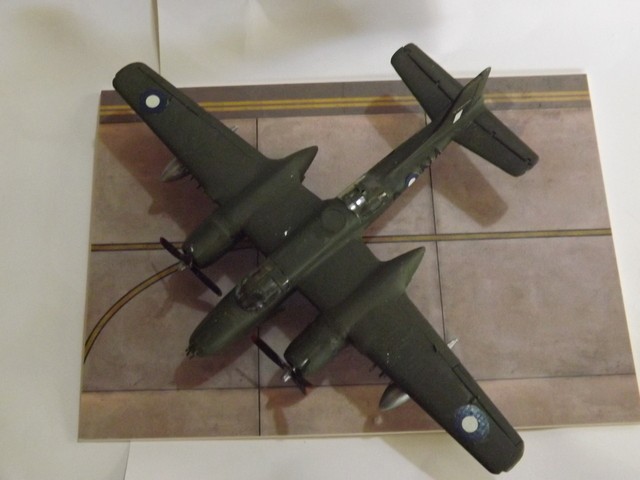
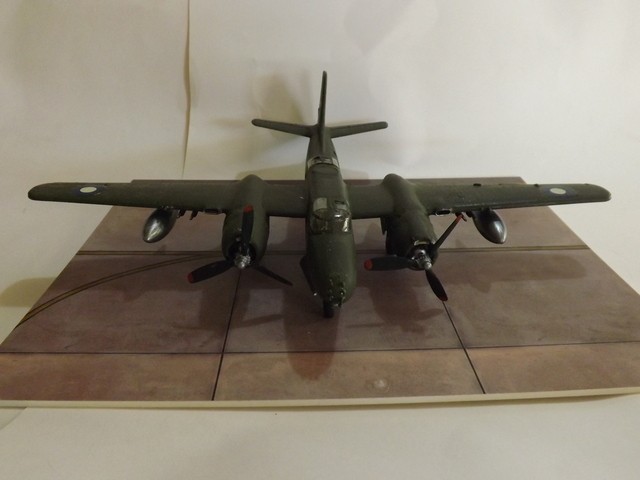
The Model
The model is the venerable 1/72 Airfix kit, hand painted in deep foliage green. It has had it's gun turrets removed to save weight and because there was little likelihood of them being much use against any intercepting fighters at night. It was brush painted and the markings are from an old ESCI Mosquito decal set, depicting a fighter from 1 Squadron RAAF.
The Douglas A-26 Invader (designated B-26 between 1948 and 1965) is a twin-engined light bomber and ground attack aircraft. Built by Douglas Aircraft Company during World War II, the Invader also saw service during several major Cold War conflicts. A limited number of highly modified United States Air Force aircraft served in Southeast Asia until 1969. It was a fast aircraft capable of carrying a large bomb load. A range of guns could be fitted to produce a formidable ground-attack aircraft.
A re-designation of the type from A-26 to B-26 led to confusion with the Martin B-26 Marauder, which first flew in November 1940, some 20 months before the Douglas design's maiden flight. Although both types were powered by the widely used Pratt & Whitney R-2800 Double Wasp eighteen-cylinder, double-row radial engine, they were completely different and separate designs — the Martin bomber originated in 1939, with more than twice as many Marauders (nearly 5,300) produced in comparison to the Douglas design.
USAAF service
The Pacific
The Douglas company began delivering the production model A-26B to the United States Army Air Forces (USAAF) in August 1943 with the new bomber first seeing action with the Fifth Air Force in the Southwest Pacific theatre on 23 June 1944, when Japanese-held islands near Manokwari were attacked. The pilots in the 3rd Bomb Group's 13th Squadron, "The Grim Reapers", who received the first four A-26s for evaluation, found the view from the cockpit to be restricted by the engines and thus inadequate for low-level attack. General George Kenney, commander of the Far East Air Forces stated that, "We do not want the A-26 under any circumstances as a replacement for anything."
Until changes could be made, the 3d Bomb Group requested additional Douglas A-20 Havocs, although both types were used in composite flights. The 319th Bomb Group worked up on the A-26 in March 1945, joining the initial 3rd BG, with the 319th flying until 12 August 1945. The A-26 operations wound down in mid-August 1945 with only a few dozen missions flown. Several of the A-20 and B-25 AAF units in the Pacific received the A-26 for trials, in limited quantities.
Europe
Douglas needed better results from the Invader's second combat test, so A-26s began arriving in Europe in late September 1944 for assignment to the Ninth Air Force. The initial deployment involved 18 aircraft and crews assigned to the 553d Squadron of the 386th Bomb Group. This unit flew its first mission on 6 September 1944. No aircraft were lost on the eight test missions, and the Ninth Air Force announced that it was happy to replace all of its A-20s and B-26s with the A-26 Invader.
The first group to fully convert to the A-26B was 416th Bombardment Group with which it entered combat on 17 November, and the 409th Bombardment Group, whose A-26s became operational in late November.[16] Due to a shortage of A-26C variants, the groups flew a combined A-20/A-26 unit until deliveries of the glass-nose version caught up. Besides bombing and strafing, tactical reconnaissance and night interdiction missions were undertaken successfully. In contrast to the Pacific-based units, the A-26 was well received by pilots and crew alike, and by 1945, the 9th AF had flown 11,567 missions, dropping 18,054 tons of bombs, recording seven confirmed kills while losing 67 aircraft.
In Italy the Twelfth Air Force's 47th Bomb Group also received the A-26, starting in January 1945. They were used against German transport links, but also for direct support and interdiction against tanks and troop concentrations in the Po valley in the final campaigns in Italy.
RAAF service
Because of the USAAF's Pacific air force rejection, many A-26s were left in aircraft parks in Australia after being delivered. The RAAF discovered them, just at the time it was having considerable problems with the manufacture of the Mosquito. The de Havilland aircraft, made of wood faired badly before the elements in the Tropics. The glues used to bind it together started failing and aircraft were falling apart, literally rotting before their pilots' eyes. The A-26's performance was nearly as good as the Mosquito's and made of metal, did not suffer the same problems. So, late in 1944, the RAAF requested access to several Invaders for trials purposes. The RAAF's pilots were initially reluctant, after hearing the bad stories of the USAAF's experience with the aircraft in action against the Japanese. However, once they had tried it, they became enthusiastic.
The RAAF adopted the Invader as a replacement to the Mosquito. It was durable and it was fast and manoeuvrable and carried an excellent war load. Used as a night time intruder, the squadrons that adopted the aircraft found it an excellent mount.
At war's end, Australia found itself with a considerable surplus resulted from it's positive Lend-Lease ratio caused by it's supply of large quantities of grain and other agricultural products. After negotiations with the US Government it found itself heir to a large quantity of surplus US war materiale'. This included several thousand of the latest USAAF aircraft, including a large quantity of A-26 Invaders. Sufficient to keep several squadrons supplied with aircraft for some time to come.
The A-26 lasted in RAAF service until the end of the 1950s, when the last were finally retired, replaced by Canberra jet bombers. The A-26 served not only in the closing stages of the Pacific War but also in the Occupation of Japan and the Korean War. It's extended range allowed it to loiter for long periods over North Korea, interdicting the Communists' logistics effort. One was shot down in the early days of the war by a MiG-15 fighter. However, after they were switched to night time attacks only, all possible involvement with Communist fighters ended.


The Model
The model is the venerable 1/72 Airfix kit, hand painted in deep foliage green. It has had it's gun turrets removed to save weight and because there was little likelihood of them being much use against any intercepting fighters at night. It was brush painted and the markings are from an old ESCI Mosquito decal set, depicting a fighter from 1 Squadron RAAF.
Handley Page Victoria EB Mk.2
In 1959, Handley Page identified that there was an increasing need for a higher speed replacement for the English Electric Canberra medium bomber. While the idea of higher, faster, carrying a nuclear bomb was predominate in the minds of many aeronautical people at the time, as epitomised by the TSR.2 and the Mirage IV, there was still a need for a conventional "bomb truck" which could carry a reasonable bombload, a reasonable distance. The design office decided to offer a scaled down version of their Victor heavy bomber. Equipped with four Rolls Royce Avon engines, the new bomber was expected to be capable of Mach 0.9 performance with a range of approximately 1,200 miles, carrying a 10,000 lb bomb load.
The Handley Page board gave the go ahead, in high secrecy for a private venture bomber to be produced. While the rest of the aviation world's attention was firmly focused on the upcoming TSR.2 bomber and F-111or the Mirage IV, their plans went ahead. First flying in late 1961, the aircraft was a near complete success. Based on the Victor B.1 the bomber flew at near the speed of sound and to a range of 1,400 miles with ease while carrying it's bombload.
Seeking to repeat the success of the Canberra H.P. chose to name the aircraft after a city in the Commonwealth, in this case Victoria, Canada. Inviting the Canadian Prime Minister, John Diefenbaker, to officially unveil the new bomber, he declined making any statement on whether the RCAF would order the aircraft. The Canadian Air Force was beginning to go through considerable turmoil, with its forced amalgamation with the other two Canadian armed services and was not interested in acquiring a medium bomber, which when compared to the TSR.2 and the F-111 was considered rather passe'.
New Zealand, however, was very interested in moving up a “notch”. The RNZAF was equipped with older Canberras. It's commitments in South-East Asia were increasing and it was foreseen that it would need newer aircraft to meet them in Malaysia in particular. When Konfrontasi (Confrontation) with Indonesia broke out in 1964, the decision had just been taken for the RNZAF to acquire a squadron of the new bomber. Several other countries followed suit, with Chile and Venezuela acquiring a squadron each. In 1966, the RNZAF decided that another squadron was required and acquired them. By then, New Zealand and Australia were committed to the defence of South Vietnam as well. The RNZAF aircraft flew missions over North and South Vietnam.
In 1967, North Vietnam had acquired SA-2 and SA-3 surface-to-air missiles. The USA responded by forming specialised SEAD (Suppression of Enemy Air Defence) squadrons, flying “Wild Weasel” missions. The RNZAF responded by adding increased ECM and ECCM equipment to their aircraft. In 1970, it began, with American agreement and co-operation to create a new version of the Victoria, which became a dedicate special missions aircraft. Grumman aircraft are appointed as prime contractor. In 1971, the decision was taken to graft an entire new nose section onto the Victoria bomber, from the EA-6B Prowler special missions aircraft. It would carry most of the sensors required, with support equipment housed in part of the bombbay behind. The fuselage diameters were similar and little work was required to match the takeup points.
The result was the Victoria EB Mk.2, a model unique to the RNZAF. It carried four crew and extensive ECM equipment, which enabled it to act as a blanket jammer. It could also carry a reduced bombload and had two external hard points on the wings for the carriage of ECM pods. However, the eight aircraft acquired arrived too late to take part in the war against North Vietnam. It's service life was to be relatively long but uneventful, with it's only aggressive use in exercises with the RAAF (by this time, New Zealand had been ejected from the ANZUS treaty because of the anti-nuclear stance of it's Government under David Lange). The aircraft proved, despite it's apparent age, challenging to the RAAF's fighter squadrons, equipped first with Mirages and then later, F/A-18s.
The Victoria EB Mk.2 served until the late 1980s, when with the down turn in the Cold War and it's eventual end, the decision was taken to reduce the size of the RNZAF and retire this unique aircraft.
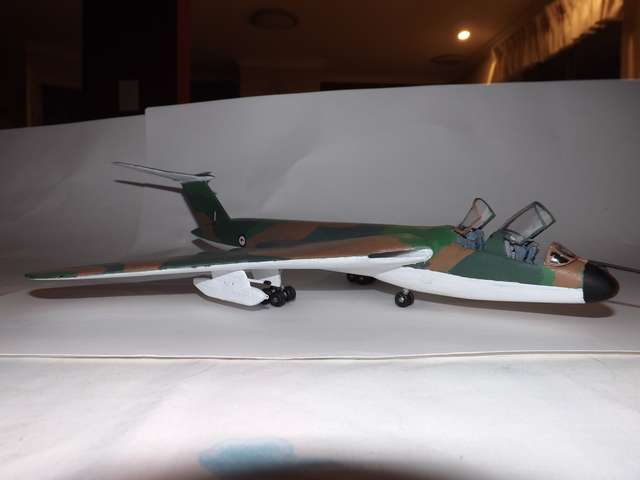
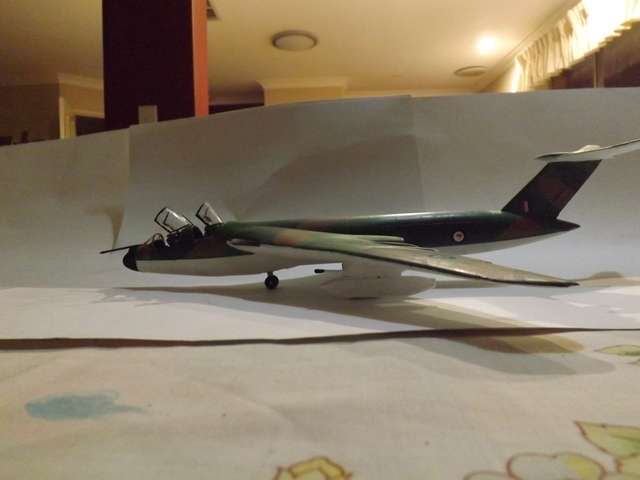
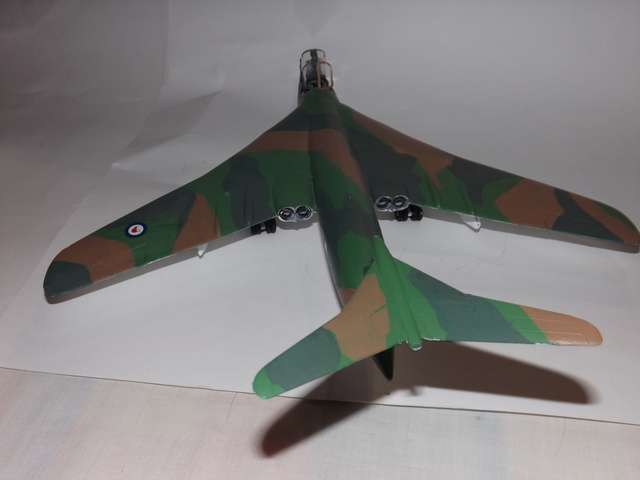
The Model
The model is an old Lindberg 1/96 scale H.P. Victor to which the nose from a Hobbycraft EA-6B Prowler has been attached. The two nearly matched perfectly. The idea was provided by an illustration at BTS by someone who has since removed his posts from the forum. The two nearly matched perfectly. It is painted in a late SEA Camouflage, with minimal markings.
In 1959, Handley Page identified that there was an increasing need for a higher speed replacement for the English Electric Canberra medium bomber. While the idea of higher, faster, carrying a nuclear bomb was predominate in the minds of many aeronautical people at the time, as epitomised by the TSR.2 and the Mirage IV, there was still a need for a conventional "bomb truck" which could carry a reasonable bombload, a reasonable distance. The design office decided to offer a scaled down version of their Victor heavy bomber. Equipped with four Rolls Royce Avon engines, the new bomber was expected to be capable of Mach 0.9 performance with a range of approximately 1,200 miles, carrying a 10,000 lb bomb load.
The Handley Page board gave the go ahead, in high secrecy for a private venture bomber to be produced. While the rest of the aviation world's attention was firmly focused on the upcoming TSR.2 bomber and F-111or the Mirage IV, their plans went ahead. First flying in late 1961, the aircraft was a near complete success. Based on the Victor B.1 the bomber flew at near the speed of sound and to a range of 1,400 miles with ease while carrying it's bombload.
Seeking to repeat the success of the Canberra H.P. chose to name the aircraft after a city in the Commonwealth, in this case Victoria, Canada. Inviting the Canadian Prime Minister, John Diefenbaker, to officially unveil the new bomber, he declined making any statement on whether the RCAF would order the aircraft. The Canadian Air Force was beginning to go through considerable turmoil, with its forced amalgamation with the other two Canadian armed services and was not interested in acquiring a medium bomber, which when compared to the TSR.2 and the F-111 was considered rather passe'.
New Zealand, however, was very interested in moving up a “notch”. The RNZAF was equipped with older Canberras. It's commitments in South-East Asia were increasing and it was foreseen that it would need newer aircraft to meet them in Malaysia in particular. When Konfrontasi (Confrontation) with Indonesia broke out in 1964, the decision had just been taken for the RNZAF to acquire a squadron of the new bomber. Several other countries followed suit, with Chile and Venezuela acquiring a squadron each. In 1966, the RNZAF decided that another squadron was required and acquired them. By then, New Zealand and Australia were committed to the defence of South Vietnam as well. The RNZAF aircraft flew missions over North and South Vietnam.
In 1967, North Vietnam had acquired SA-2 and SA-3 surface-to-air missiles. The USA responded by forming specialised SEAD (Suppression of Enemy Air Defence) squadrons, flying “Wild Weasel” missions. The RNZAF responded by adding increased ECM and ECCM equipment to their aircraft. In 1970, it began, with American agreement and co-operation to create a new version of the Victoria, which became a dedicate special missions aircraft. Grumman aircraft are appointed as prime contractor. In 1971, the decision was taken to graft an entire new nose section onto the Victoria bomber, from the EA-6B Prowler special missions aircraft. It would carry most of the sensors required, with support equipment housed in part of the bombbay behind. The fuselage diameters were similar and little work was required to match the takeup points.
The result was the Victoria EB Mk.2, a model unique to the RNZAF. It carried four crew and extensive ECM equipment, which enabled it to act as a blanket jammer. It could also carry a reduced bombload and had two external hard points on the wings for the carriage of ECM pods. However, the eight aircraft acquired arrived too late to take part in the war against North Vietnam. It's service life was to be relatively long but uneventful, with it's only aggressive use in exercises with the RAAF (by this time, New Zealand had been ejected from the ANZUS treaty because of the anti-nuclear stance of it's Government under David Lange). The aircraft proved, despite it's apparent age, challenging to the RAAF's fighter squadrons, equipped first with Mirages and then later, F/A-18s.
The Victoria EB Mk.2 served until the late 1980s, when with the down turn in the Cold War and it's eventual end, the decision was taken to reduce the size of the RNZAF and retire this unique aircraft.



The Model
The model is an old Lindberg 1/96 scale H.P. Victor to which the nose from a Hobbycraft EA-6B Prowler has been attached. The two nearly matched perfectly. The idea was provided by an illustration at BTS by someone who has since removed his posts from the forum. The two nearly matched perfectly. It is painted in a late SEA Camouflage, with minimal markings.
nicely done , and then AUstralia too adopts the F101 along with CanadaThe first “emergency fighter” that the RAF received from the USAF were second-hand F-101B Voodoos.
Percival Provost, Royal Rhodesian Air Force, 1960
The Percival P.56 Provost was a British basic trainer that was developed for the Royal Air Force in the 1950s as a replacement for the Percival Prentice. It was a low-wing monoplane with a fixed, tailwheel undercarriage and like the Prentice had a side-by-side seating arrangement.
he Provost was later adapted to make use of a turbojet engine, producing the BAC Jet Provost. The type was withdrawn in the 1960s, in favour of its jet-powered successor.
The Provost design is attributed to the Polish-born Aeronautical Engineer, Henry Millicer. Millicer later moved to Australia where he also designed the award-winning Victa Airtourer light aircraft. The Provost was designed to Air Ministry specification T.16/48 for a single-engined basic trainer aircraft to meet Operational Requirement 257 for a Percival Prentice replacement. The specification was issued on 11 September 1948 and the ministry received over 30 proposals. Two designs were chosen for prototype construction, the Handley Page H.P.R. 2 and the Percival P.56. Percival was given a contract dated 13 January 1950 to build two Cheetah-powered prototypes. The company also built a third prototype with an Alvis Leonides Mk 25 engine.
The Armstrong Siddeley Cheetah-powered prototype serial number WE522 first flew on 24 February 1950. After evaluation against the H.P.R. 2 at Boscombe Down, the Leonides-powered P.56 was selected for production as the Provost T.1, with an initial order for 200 aircraft being placed on 29 May 1951. In 1961, production of the type ended with a total of 461 aircraft having been completed.
In 1953, the Provost entered service with the RAF, the first batch of aircraft were delivered to the Central Flying School (CFS) at RAF South Cerney. The CFS carried out intensive flight trials in May and June 1953 prior to instructor training commencing. The Provost was more capable than the Prentice it replaced, which allowed students to move straight on to the De Havilland Vampire after completing training on the Provost. On 1 July 1953, 6 Flying Training School at RAF Ternhill started to re-equip with the Provost. The first pupil training course to use the Provost started in October 1953. No. 22 Flying Training School at RAF Syerston was the next to convert and it was followed by 2 FTS at RAF Cluntoe, Northern Ireland, 3 FTS at RAF Feltwell and then the Royal Air Force College at RAF Cranwell.
From 1956 the Provost was issued to some University Air Squadrons, the first being the Queen's University Air Squadron, Belfast in January 1956. The last RAF production aircraft was delivered in April 1956. The aircraft served with the RAF until the early 1960s, when it was replaced by the Jet Provost. A few Provosts continued in service during the 1960s with the Central Navigation & Control School (later Central Air Traffic Control School) at RAF Shawbury until the last example was retired in 1969. Several retired airframes were renumbered with maintenance serials and used for training of airframe and engine tradesmen. At least five Percival Provost have survived as civilian aircraft.
The first export order was placed in May 1953 by Southern Rhodesia, for four T.1 aircraft which were designated the T.51. Later, the Royal Rhodesian Air Force followed with an order for twelve armed trainers, designated the T.52, which were delivered in 1955.
Provosts of the RRAF saw action against the various Black insurgent groups throughout the 1960s. Armed with 2 x 7.62mm machine guns, four 5 inch rockets or two 250 lb bombs, the aircraft flew light strike and observation missions deep into the Rhodesian bush, several being holed and two being downed by anti-aircraft fire.
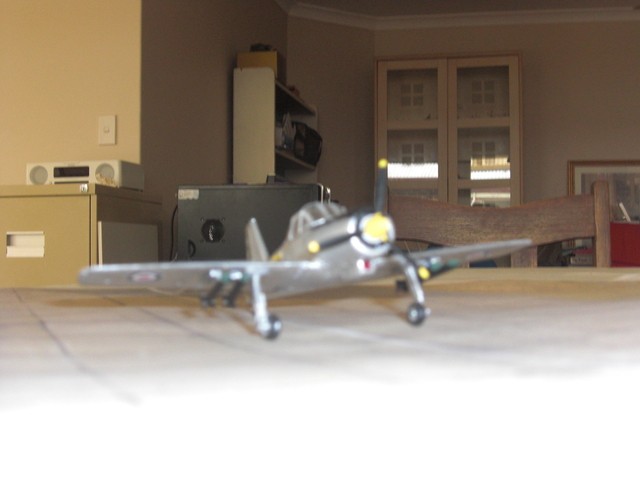
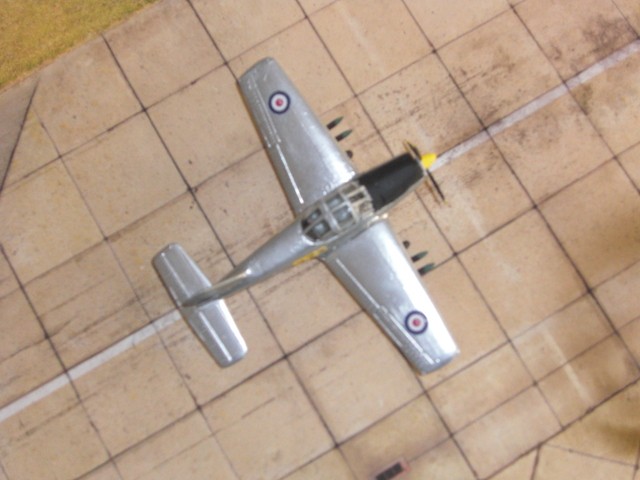
The Model
The model is a venerable Matchbox 1/72 Percival Provost. It has been spray painted with silver paint and touched up by brush. It has had rockets added from the spare parts bin and the decals are courtesy of Kit’s Decals.
The Percival P.56 Provost was a British basic trainer that was developed for the Royal Air Force in the 1950s as a replacement for the Percival Prentice. It was a low-wing monoplane with a fixed, tailwheel undercarriage and like the Prentice had a side-by-side seating arrangement.
he Provost was later adapted to make use of a turbojet engine, producing the BAC Jet Provost. The type was withdrawn in the 1960s, in favour of its jet-powered successor.
The Provost design is attributed to the Polish-born Aeronautical Engineer, Henry Millicer. Millicer later moved to Australia where he also designed the award-winning Victa Airtourer light aircraft. The Provost was designed to Air Ministry specification T.16/48 for a single-engined basic trainer aircraft to meet Operational Requirement 257 for a Percival Prentice replacement. The specification was issued on 11 September 1948 and the ministry received over 30 proposals. Two designs were chosen for prototype construction, the Handley Page H.P.R. 2 and the Percival P.56. Percival was given a contract dated 13 January 1950 to build two Cheetah-powered prototypes. The company also built a third prototype with an Alvis Leonides Mk 25 engine.
The Armstrong Siddeley Cheetah-powered prototype serial number WE522 first flew on 24 February 1950. After evaluation against the H.P.R. 2 at Boscombe Down, the Leonides-powered P.56 was selected for production as the Provost T.1, with an initial order for 200 aircraft being placed on 29 May 1951. In 1961, production of the type ended with a total of 461 aircraft having been completed.
In 1953, the Provost entered service with the RAF, the first batch of aircraft were delivered to the Central Flying School (CFS) at RAF South Cerney. The CFS carried out intensive flight trials in May and June 1953 prior to instructor training commencing. The Provost was more capable than the Prentice it replaced, which allowed students to move straight on to the De Havilland Vampire after completing training on the Provost. On 1 July 1953, 6 Flying Training School at RAF Ternhill started to re-equip with the Provost. The first pupil training course to use the Provost started in October 1953. No. 22 Flying Training School at RAF Syerston was the next to convert and it was followed by 2 FTS at RAF Cluntoe, Northern Ireland, 3 FTS at RAF Feltwell and then the Royal Air Force College at RAF Cranwell.
From 1956 the Provost was issued to some University Air Squadrons, the first being the Queen's University Air Squadron, Belfast in January 1956. The last RAF production aircraft was delivered in April 1956. The aircraft served with the RAF until the early 1960s, when it was replaced by the Jet Provost. A few Provosts continued in service during the 1960s with the Central Navigation & Control School (later Central Air Traffic Control School) at RAF Shawbury until the last example was retired in 1969. Several retired airframes were renumbered with maintenance serials and used for training of airframe and engine tradesmen. At least five Percival Provost have survived as civilian aircraft.
The first export order was placed in May 1953 by Southern Rhodesia, for four T.1 aircraft which were designated the T.51. Later, the Royal Rhodesian Air Force followed with an order for twelve armed trainers, designated the T.52, which were delivered in 1955.
Provosts of the RRAF saw action against the various Black insurgent groups throughout the 1960s. Armed with 2 x 7.62mm machine guns, four 5 inch rockets or two 250 lb bombs, the aircraft flew light strike and observation missions deep into the Rhodesian bush, several being holed and two being downed by anti-aircraft fire.


The Model
The model is a venerable Matchbox 1/72 Percival Provost. It has been spray painted with silver paint and touched up by brush. It has had rockets added from the spare parts bin and the decals are courtesy of Kit’s Decals.
Shorts Tucano TR.3, RAF service, Afghanistan, 2005
The Short Tucano is a two-seat turboprop basic trainer built by Short Brothers in Belfast, Northern Ireland. It is a licence-built version of the Brazilian Embraer EMB-312 Tucano.
Development of the Tucano started in May 1984 after an agreement between Embraer and Short Brothers to meet a requirement to replace the BAC Jet Provost as a basic trainer with the Royal Air Force. The Royal Air Force issued Air Staff Target 412 to define the requirement for a high-performance turboprop trainer. A shortlist of designs competed for the contract; the other types considered were the Pilatus PC-9, the NDN-1T Turbo-Firecracker and the Australian Aircraft Consortium (AAC) A.20 Wamira II.
The first standard production model T.Mk 1 was flown on 30 December 1986 and the official rollout took place on 20 January 1987. A second prototype flew on 10 March 1987, and, by April a third had joined the test fleet for clearance and final testing at Boscombe Down. The fourth build aircraft was the first delivered to the RAF on 16 June 1988 at the Central Flying School,[5] while the last delivery to RAF occurred 25 January 1993.
In addition to the revised engine, the major differences of the Shorts Tucano are a strengthened airframe for an improved fatigue life, a cockpit layout similar to the Hawk advanced trainer, a revised oxygen system, a flight data recorder, a four-bladed propeller, ventral airbrake and restyled wingtips. Two Martin-Baker MB 8LC ejection seats are used and the canopy was modified to meet the RAF's bird strike requirements. During its production run, Shorts commonly promoted the airframe as being "100% British-built". In order to meet RAF requirements, the EMB-312 has some 900 modifications reducing commonality with the original aircraft to only 50%
In 2001, the RAE (Royal Aircraft Establishment) decided to use the basic Tucano airframe for a trials tactical reconnaissance aircraft. One aircraft was selected and modified. It’s wing tips were extended by six feet on each side and a specialised tactical reconnaissance pod was attached under the fuselage centreline. The rear cockpit was used to house electronics gear. Cruising at 50,000 feet, high over the battlefield the aircraft had an IIR (Imaging Infra-red) system and a Laser Designator housed in a turret at the front of the pod and a small warning radar housed in it’s rear, for defensive purposes. Equipped with a direct datalink to a ground station via satellite, the aircraft was able to perform direct reconnaissance missions under command of the ground commander conducting operations, as well as being able to direct airstrikes using it’s laser designator to guide bombs onto the target.
With the commitment of British forces to the war in Afghanistan, the RAF decided to undertake combat trials with the aircraft. These were most successful and within a year, a squadron had been formed to undertake operations with the now designated Tucano TR.3 aircraft. 12 airframes were selected for conversion. The only noticeable differences were the extended wingtips and the metal cover over the rear cockpit.

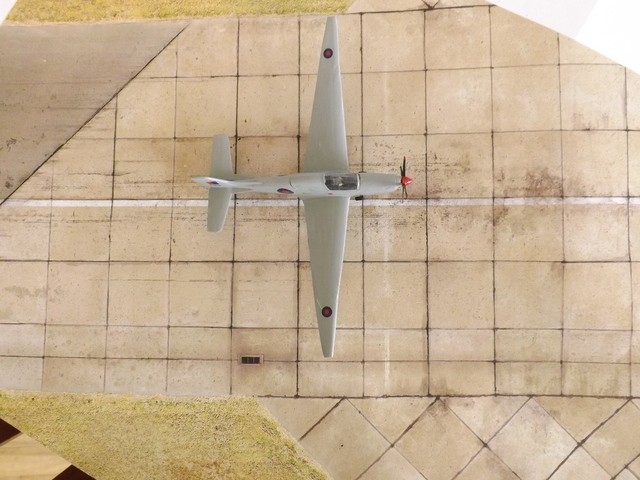

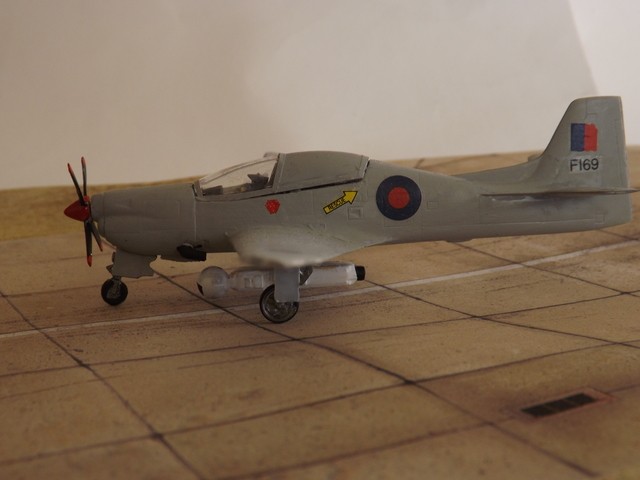
The Model
The model is a 1/72 scale Premier Models Shorts Tucano. It has been brushpainted and the decals came from the spare box. It’s wingtips have been extended with plasticard and the rear cockpit painted over. The decals came from the sparesbox, as did the pod on the centreline. The observation turret at the front is a fishing weight.
The Short Tucano is a two-seat turboprop basic trainer built by Short Brothers in Belfast, Northern Ireland. It is a licence-built version of the Brazilian Embraer EMB-312 Tucano.
Development of the Tucano started in May 1984 after an agreement between Embraer and Short Brothers to meet a requirement to replace the BAC Jet Provost as a basic trainer with the Royal Air Force. The Royal Air Force issued Air Staff Target 412 to define the requirement for a high-performance turboprop trainer. A shortlist of designs competed for the contract; the other types considered were the Pilatus PC-9, the NDN-1T Turbo-Firecracker and the Australian Aircraft Consortium (AAC) A.20 Wamira II.
The first standard production model T.Mk 1 was flown on 30 December 1986 and the official rollout took place on 20 January 1987. A second prototype flew on 10 March 1987, and, by April a third had joined the test fleet for clearance and final testing at Boscombe Down. The fourth build aircraft was the first delivered to the RAF on 16 June 1988 at the Central Flying School,[5] while the last delivery to RAF occurred 25 January 1993.
In addition to the revised engine, the major differences of the Shorts Tucano are a strengthened airframe for an improved fatigue life, a cockpit layout similar to the Hawk advanced trainer, a revised oxygen system, a flight data recorder, a four-bladed propeller, ventral airbrake and restyled wingtips. Two Martin-Baker MB 8LC ejection seats are used and the canopy was modified to meet the RAF's bird strike requirements. During its production run, Shorts commonly promoted the airframe as being "100% British-built". In order to meet RAF requirements, the EMB-312 has some 900 modifications reducing commonality with the original aircraft to only 50%
In 2001, the RAE (Royal Aircraft Establishment) decided to use the basic Tucano airframe for a trials tactical reconnaissance aircraft. One aircraft was selected and modified. It’s wing tips were extended by six feet on each side and a specialised tactical reconnaissance pod was attached under the fuselage centreline. The rear cockpit was used to house electronics gear. Cruising at 50,000 feet, high over the battlefield the aircraft had an IIR (Imaging Infra-red) system and a Laser Designator housed in a turret at the front of the pod and a small warning radar housed in it’s rear, for defensive purposes. Equipped with a direct datalink to a ground station via satellite, the aircraft was able to perform direct reconnaissance missions under command of the ground commander conducting operations, as well as being able to direct airstrikes using it’s laser designator to guide bombs onto the target.
With the commitment of British forces to the war in Afghanistan, the RAF decided to undertake combat trials with the aircraft. These were most successful and within a year, a squadron had been formed to undertake operations with the now designated Tucano TR.3 aircraft. 12 airframes were selected for conversion. The only noticeable differences were the extended wingtips and the metal cover over the rear cockpit.




The Model
The model is a 1/72 scale Premier Models Shorts Tucano. It has been brushpainted and the decals came from the spare box. It’s wingtips have been extended with plasticard and the rear cockpit painted over. The decals came from the sparesbox, as did the pod on the centreline. The observation turret at the front is a fishing weight.
Thought I may as well...
After the victory of the Soviet Union in the war against Poland in 1922 they continued their expansion into Eastern Europe. By 1930 Soviet puppets states included Romania, Hungry, Bulgaria, Finland and the Baltic States. Those in Western Europe had little choice but to abandon their plans for a neutered Germany, especially as East Prussia was now surrounded by hostile forces that the West was defending against a force they could not hope to conquer, defeat yes, but not conquer. By 1940 a tense standoff was the norm.
The Soviets did not only hold half of Europe but had expanded into Mongolia and Northern China. Meanwhile they had had more success than they had hopped for in Central America. The winning side in the Mexican civil had been backed by the Bolshevik’s and became a violent regime, going so far as Stalin himself had been shocked, intent on bringing true freedom to all in the Americas and had pushed their presence to the south. By 1934 Guatemala, El Salvador, Honduras, Nicaragua where under total control of the Mexican and puppet governments. They also backed large scale insurrections and guerrilla campaigns to the south.
For it’s part the US stayed out of any confrontation even when atrocities were perpetrated within plan sight of their border. Border guards and police were fired when they tried to help those being murdered. A strict non-interventionist government headed by joseph E Ransdell had vowed after the horror of the Great War no American citizen would have their life wasted in any way, shape or form. The 20th amendment of the US constitution forbade the use of aircraft that in any way could be considered capable of war.
4th July 1939 Mexico invaded a wholly unprepared USA. Within two days El Paso and Brownsville had fallen, and San Diego was in grave danger of falling itself.
Volunteer Air Force in The United States
14th January 1940
Fighters
Avia B-534 4 sqd’s
Arado Ar65/68 2 sqd’s
Dewoitine D501 3 sqd’s
Fiat CR32 3 sqd’s
Gloster Gauntlet 6 sqd’s
Gloster Gladiator 12 sqd’s
Hawker Fury II 3 sqd’s
Hawker Hurricane 5 sqd’s
Messerschmitt Bf109 3 sqd’s
Bombers
Amiot 140/143 2 sqd’s
AW Whitley 1 sqd
Bloch 200 2 sqd’s
Fairey Hendon3 sqd’s
Fairey Battle 2 sqd’s
Handley Page Heyford 3 sqd’s
Junkers Ju 86 3 sqd’s
Savoia-Marchetti SM81 2 sqd’s
Vickers Wellesley 1 sqd
Close Support/Ground Attack
Heinkel He51 4 sqd’s
Henschel Hs123 2 sqd’s
Transport
Douglas Dc-2/Dc-3 23 sqd’s
Maritime Patrol
Douglas Dc-2/Dc-3 3 sqd’s
Various European aircraft, 37 in number
The number of aircraft in any given Squadron could be between 4 and 15 planes at any given time.
All aircraft excepting transport and maritime patrol were piloted, serviced and supplied by non US service personal.
After the victory of the Soviet Union in the war against Poland in 1922 they continued their expansion into Eastern Europe. By 1930 Soviet puppets states included Romania, Hungry, Bulgaria, Finland and the Baltic States. Those in Western Europe had little choice but to abandon their plans for a neutered Germany, especially as East Prussia was now surrounded by hostile forces that the West was defending against a force they could not hope to conquer, defeat yes, but not conquer. By 1940 a tense standoff was the norm.
The Soviets did not only hold half of Europe but had expanded into Mongolia and Northern China. Meanwhile they had had more success than they had hopped for in Central America. The winning side in the Mexican civil had been backed by the Bolshevik’s and became a violent regime, going so far as Stalin himself had been shocked, intent on bringing true freedom to all in the Americas and had pushed their presence to the south. By 1934 Guatemala, El Salvador, Honduras, Nicaragua where under total control of the Mexican and puppet governments. They also backed large scale insurrections and guerrilla campaigns to the south.
For it’s part the US stayed out of any confrontation even when atrocities were perpetrated within plan sight of their border. Border guards and police were fired when they tried to help those being murdered. A strict non-interventionist government headed by joseph E Ransdell had vowed after the horror of the Great War no American citizen would have their life wasted in any way, shape or form. The 20th amendment of the US constitution forbade the use of aircraft that in any way could be considered capable of war.
4th July 1939 Mexico invaded a wholly unprepared USA. Within two days El Paso and Brownsville had fallen, and San Diego was in grave danger of falling itself.
Volunteer Air Force in The United States
14th January 1940
Fighters
Avia B-534 4 sqd’s
Arado Ar65/68 2 sqd’s
Dewoitine D501 3 sqd’s
Fiat CR32 3 sqd’s
Gloster Gauntlet 6 sqd’s
Gloster Gladiator 12 sqd’s
Hawker Fury II 3 sqd’s
Hawker Hurricane 5 sqd’s
Messerschmitt Bf109 3 sqd’s
Bombers
Amiot 140/143 2 sqd’s
AW Whitley 1 sqd
Bloch 200 2 sqd’s
Fairey Hendon3 sqd’s
Fairey Battle 2 sqd’s
Handley Page Heyford 3 sqd’s
Junkers Ju 86 3 sqd’s
Savoia-Marchetti SM81 2 sqd’s
Vickers Wellesley 1 sqd
Close Support/Ground Attack
Heinkel He51 4 sqd’s
Henschel Hs123 2 sqd’s
Transport
Douglas Dc-2/Dc-3 23 sqd’s
Maritime Patrol
Douglas Dc-2/Dc-3 3 sqd’s
Various European aircraft, 37 in number
The number of aircraft in any given Squadron could be between 4 and 15 planes at any given time.
All aircraft excepting transport and maritime patrol were piloted, serviced and supplied by non US service personal.
Last edited:
Real Life Build - The De Havilland Venom FB.1, 45 Squadron, Butterworth, 1956.
In 1948, de Havilland proposed a development of the Vampire, furnished with a thinner wing and a more powerful engine, to serve as a high altitude fighter, designated as the Vampire FB 8. The design gradually shifted, becoming the DH 112 Venom, in order to fill an Air Ministry requirement, Specification F.15/49, which sought a fast, manoeuvrable and capable fighter-bomber to replace the Royal Air Force's (RAF) existing Vampires in that capacity. From the onset, the envisioned role had been intended as an interim fighter-bomber, while the development of aircraft capable of even greater performance had already been anticipated by the service.
Although generally similar in appearance to the preceding Vampire, sharing the distinctive twin-boom tail and composite wood/metal structure, the Venom was a completely new design. As originally designed, it was powered by the de Havilland Ghost 103 turbojet engine, which was capable of generating 4,850lb of thrust, considerably more powerful than the earlier de Havilland Goblin that had been used on the Vampire. The Venom adopted a wing designed with a leading edge sweepback of 17.6 degrees, a minimised thickness/chord ratio reduced from 14 per cent to 10 per cent, while the trailing edge was straight; a pair of optionally-fitted wing tip tanks were also designed to be fitted without any negative impact on the aircraft's overall combat maneuvering capability.
The Venom FB 1 was powered by a single 4,850 lbf (21.6 kN) thrust Ghost 48 Mk.1 turbojet engine; later marks were equipped with increasingly powerful models. The engine was ignited using explosive cartridges, known as Coffman engine starters; at the time, many operators were not previously familiar with such means of start up. Early production models lacked ejection seats, which was subject to official criticism; in response, later production models were furnished with them. The airframe itself had a relatively short life due to having been designed for its role as a short term interim aircraft pending development of what would become the Hawker Hunter; in Swiss service, where the type was subject to a lengthy service life, several strengthening modifications were performed to more than double its viable lifespan. It was known for its simplicity in construction and relative cost-effectiveness, which contributed to its popularity to export customers.
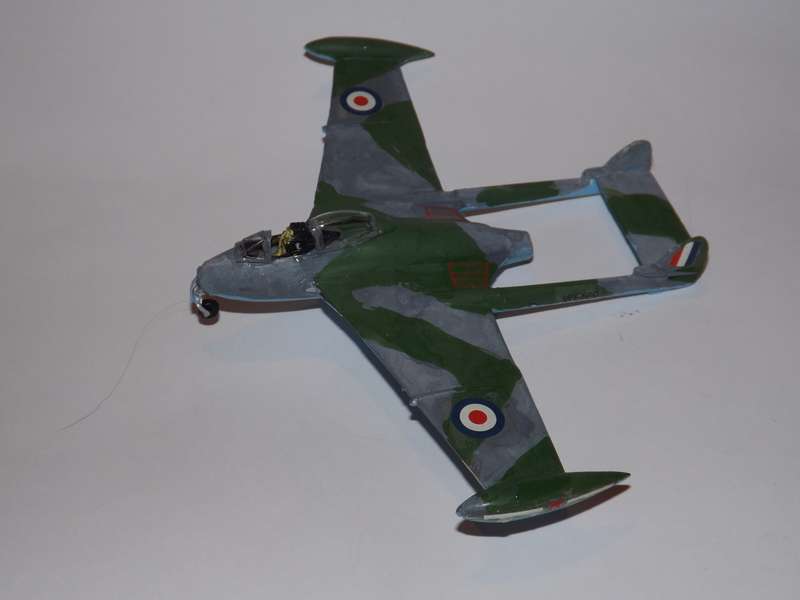

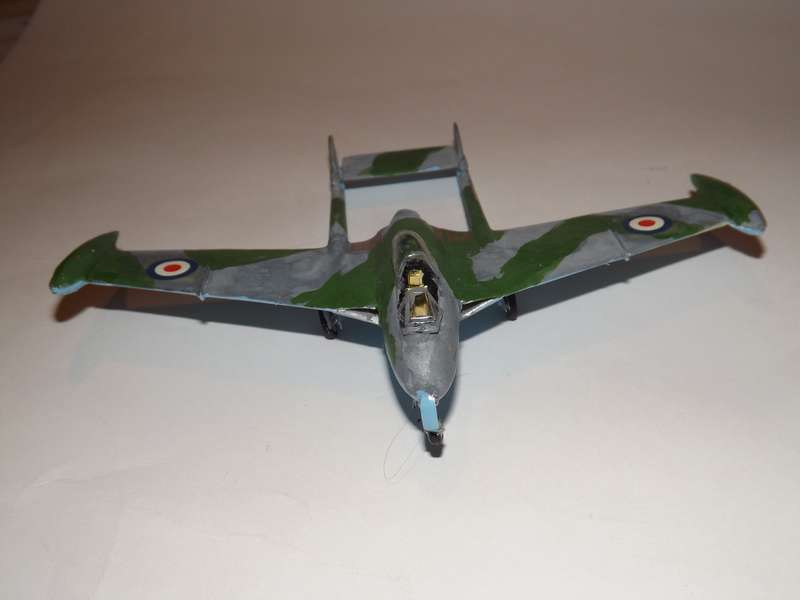
The Kit
Yes, this is a 1/72 scale kit. It is an ancient Aeroclub kit which I picked up from Evilbay a few years ago. It was small, simple and quite easily put together in a single evening. What was missing was room for adequate noseweights to stop it being a tail sitter. Thankfully, Aeroclub provided a metal ejection seat and I was able to put some lead foil and a largish metal nut far enough forward in the fuselage to make it sit on it’s nose. It failed to arrive with a canopy so I purchase a Pavla Vampire one which looked the part. Painted in Vallejo Acrylic paints with a hairy stick.
In 1948, de Havilland proposed a development of the Vampire, furnished with a thinner wing and a more powerful engine, to serve as a high altitude fighter, designated as the Vampire FB 8. The design gradually shifted, becoming the DH 112 Venom, in order to fill an Air Ministry requirement, Specification F.15/49, which sought a fast, manoeuvrable and capable fighter-bomber to replace the Royal Air Force's (RAF) existing Vampires in that capacity. From the onset, the envisioned role had been intended as an interim fighter-bomber, while the development of aircraft capable of even greater performance had already been anticipated by the service.
Although generally similar in appearance to the preceding Vampire, sharing the distinctive twin-boom tail and composite wood/metal structure, the Venom was a completely new design. As originally designed, it was powered by the de Havilland Ghost 103 turbojet engine, which was capable of generating 4,850lb of thrust, considerably more powerful than the earlier de Havilland Goblin that had been used on the Vampire. The Venom adopted a wing designed with a leading edge sweepback of 17.6 degrees, a minimised thickness/chord ratio reduced from 14 per cent to 10 per cent, while the trailing edge was straight; a pair of optionally-fitted wing tip tanks were also designed to be fitted without any negative impact on the aircraft's overall combat maneuvering capability.
The Venom FB 1 was powered by a single 4,850 lbf (21.6 kN) thrust Ghost 48 Mk.1 turbojet engine; later marks were equipped with increasingly powerful models. The engine was ignited using explosive cartridges, known as Coffman engine starters; at the time, many operators were not previously familiar with such means of start up. Early production models lacked ejection seats, which was subject to official criticism; in response, later production models were furnished with them. The airframe itself had a relatively short life due to having been designed for its role as a short term interim aircraft pending development of what would become the Hawker Hunter; in Swiss service, where the type was subject to a lengthy service life, several strengthening modifications were performed to more than double its viable lifespan. It was known for its simplicity in construction and relative cost-effectiveness, which contributed to its popularity to export customers.



The Kit
Yes, this is a 1/72 scale kit. It is an ancient Aeroclub kit which I picked up from Evilbay a few years ago. It was small, simple and quite easily put together in a single evening. What was missing was room for adequate noseweights to stop it being a tail sitter. Thankfully, Aeroclub provided a metal ejection seat and I was able to put some lead foil and a largish metal nut far enough forward in the fuselage to make it sit on it’s nose. It failed to arrive with a canopy so I purchase a Pavla Vampire one which looked the part. Painted in Vallejo Acrylic paints with a hairy stick.
Real World Build - Supermarine Scimitar
The Supermarine Scimitar was a British naval fighter aircraft operated by the Royal Navy Fleet Air Arm. The prototype for the eventual production version flew in January 1956 and production aircraft were delivered in 1957. It saw service with the Royal Navy from 1958 until 1969, replaced in service by the Blackburn Buccaneer.
This is my only real world build for over 30 years. It is a Scimitar from Merlin Models which I purchased off of EvilBay several years ago. It has been painted with a hairy stick and Vallejo paints. The decals came in the box and represent an aircraft from 803 Squadron FAA operating off of Ark Royal.


The Kit
The kit was an ancient Merlin Models example, painted with a hairy stick with Vallejo colours. Decals came with the kit OOB.
The Supermarine Scimitar was a British naval fighter aircraft operated by the Royal Navy Fleet Air Arm. The prototype for the eventual production version flew in January 1956 and production aircraft were delivered in 1957. It saw service with the Royal Navy from 1958 until 1969, replaced in service by the Blackburn Buccaneer.
This is my only real world build for over 30 years. It is a Scimitar from Merlin Models which I purchased off of EvilBay several years ago. It has been painted with a hairy stick and Vallejo paints. The decals came in the box and represent an aircraft from 803 Squadron FAA operating off of Ark Royal.


The Kit
The kit was an ancient Merlin Models example, painted with a hairy stick with Vallejo colours. Decals came with the kit OOB.
Nanching Q-5 “Fantan” strike aircraft
The Nanchang Q-5 (Chinese: 强-5; pinyin: Qiang-5; NATO reporting name: Fantan), also known as the A-5 in its export versions, is a Chinese-built jet ground-attack aircraft based on the Soviet MiG-19. Its main role is close air support.
The PRC was an enthusiastic user of the MiG-19, which it manufactured locally as the Shenyang J-6 from 1958. In August 1958 the People's Liberation Army requested development of a jet attack aircraft for the air support role.
Lu Xiaopeng was appointed chief designer of this project. Lu also designed the J-12 fighter jet.[2] Although based on the MiG-19, the new design, designated Qiangjiji-5 (fifth attack aircraft design), had a longer fuselage, area ruled to reduce transonic drag and accommodate a 4 m (13-ft) long internal weapons bay.[3] The air intakes were moved to the fuselage sides to make space in the nose for a planned target radar (which was never actually fitted). New wings with greater area and reduced sweep were incorporated. The Q-5 shares the J-6's Liming Wopen WP-6 A (Tumansky RD-9) turbojet engines. The redesign cost some high-altitude speed, but the Q-5 is as fast as the MiG-19/J-6 at low level, thanks largely to the area-ruled fuselage.
Fixed armament of the Q-5 was reduced to two Type 23-1 23 mm cannon with 100 rounds per gun, mounted in the wing roots. Two pylons under each wing and two pairs of tandem pylons under the engines were provided in addition to the weapons bay. A total of 1,000 kg (2,205 lb) of ordnance could be carried internally, with an additional 1,000 kg externally. On many aircraft the weapons bay is now used primarily for an auxiliary fuel tank.
About 1,000 aircraft were produced, 600 of them being the updated Q-5A. A small number, perhaps a few dozen, Q-5As were modified to carry nuclear weapons; these are believed to retain their internal weapons bay. A long-range Q-5I, introduced in 1983, added a fuel tank instead of the internal weapons bay, compensating for that with the provision of two additional underwing pylons. Some of these aircraft serve with the PLA Navy, and have apparently been equipped with radar to guide anti-ship missiles. Subsequent minor upgrades include the Q-5IA, with a new gun/bomb sighting system and avionics, and the Q-5II, with radar warning receiver (RWR).
In the 1980s, the aircraft was exported to nations such as Pakistan, Bangladesh, Myanmar, and is often known as the A-5 in those nations.
Plans for an upgraded Q-5/A-5 with Western equipment and new navigation and attack (nav/attack) systems were largely aborted following the Tiananmen Square protests of 1989, but the aircraft continues in service. It is a capable light attack aircraft, although its limited navigation and weapons-delivery systems are inferior to more modern aircraft.
In more recent years, the PLAAF has begun to field newer models of the Q-5, that incorporate some of the technology developed during the canceled Q-5M and Q-5K projects. The Q-5 introduces a nose-mounted laser rangefinder, and a laser designator is also likely to be fitted since the aircraft is said to be able to deliver laser-guided bombs. The Q-5A variant is believed to be capable of delivering nuclear munitions. The Q-5D is an upgrade with new avionics, including a HUD and a new navigation system. The Q-5E and Q-5F models are reportedly being worked on, though little is known about them at this time. One of them could potentially be the new two-seater that has been seen in a few photographs, although the two-seater could bear the designation Q-5J.
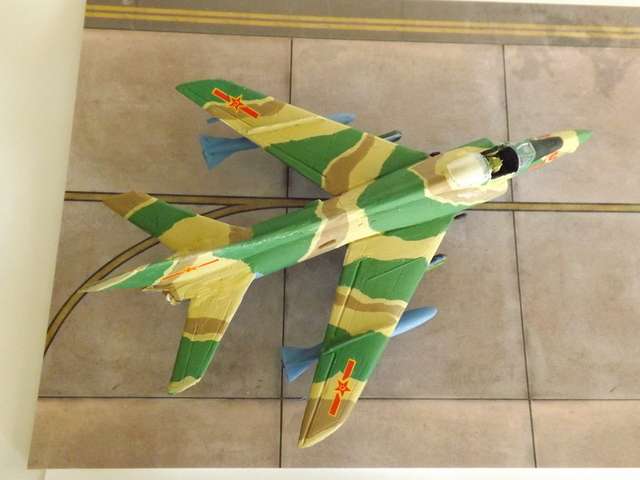
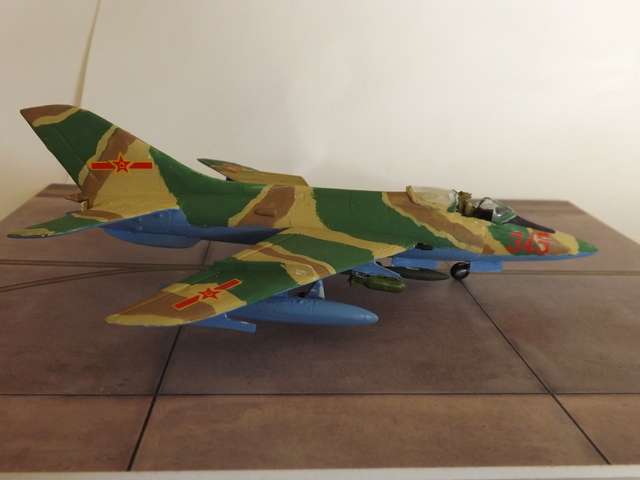
The Model

This is one of my few “real world” models. I built it because it was unusual (and I wanted to beat Trumpeter
 ). I've had this on my radar for a couple of years. I missed several vacuforms before snagging this one on EvilBay. It was primitive but a mixed media kit. The undercarriage was white metal, as was the exhausts. The drop tanks were resin. None were of a very high nature. I lost one of the exhausts to the carpet monster and have a pair of replacement ones coming in the snail mail but I thought, “why not?” I decided to post it up, still missing one exhaust. The other is unpainted. My plan is to replace both. The canopy is also vacuform and came with the kit. It is painted up as an aircraft from the regiment serving on Hainan Island in the South China Sea. Overall, it was a reasonably pleasant kit to build.
). I've had this on my radar for a couple of years. I missed several vacuforms before snagging this one on EvilBay. It was primitive but a mixed media kit. The undercarriage was white metal, as was the exhausts. The drop tanks were resin. None were of a very high nature. I lost one of the exhausts to the carpet monster and have a pair of replacement ones coming in the snail mail but I thought, “why not?” I decided to post it up, still missing one exhaust. The other is unpainted. My plan is to replace both. The canopy is also vacuform and came with the kit. It is painted up as an aircraft from the regiment serving on Hainan Island in the South China Sea. Overall, it was a reasonably pleasant kit to build.
The Nanchang Q-5 (Chinese: 强-5; pinyin: Qiang-5; NATO reporting name: Fantan), also known as the A-5 in its export versions, is a Chinese-built jet ground-attack aircraft based on the Soviet MiG-19. Its main role is close air support.
The PRC was an enthusiastic user of the MiG-19, which it manufactured locally as the Shenyang J-6 from 1958. In August 1958 the People's Liberation Army requested development of a jet attack aircraft for the air support role.
Lu Xiaopeng was appointed chief designer of this project. Lu also designed the J-12 fighter jet.[2] Although based on the MiG-19, the new design, designated Qiangjiji-5 (fifth attack aircraft design), had a longer fuselage, area ruled to reduce transonic drag and accommodate a 4 m (13-ft) long internal weapons bay.[3] The air intakes were moved to the fuselage sides to make space in the nose for a planned target radar (which was never actually fitted). New wings with greater area and reduced sweep were incorporated. The Q-5 shares the J-6's Liming Wopen WP-6 A (Tumansky RD-9) turbojet engines. The redesign cost some high-altitude speed, but the Q-5 is as fast as the MiG-19/J-6 at low level, thanks largely to the area-ruled fuselage.
Fixed armament of the Q-5 was reduced to two Type 23-1 23 mm cannon with 100 rounds per gun, mounted in the wing roots. Two pylons under each wing and two pairs of tandem pylons under the engines were provided in addition to the weapons bay. A total of 1,000 kg (2,205 lb) of ordnance could be carried internally, with an additional 1,000 kg externally. On many aircraft the weapons bay is now used primarily for an auxiliary fuel tank.
About 1,000 aircraft were produced, 600 of them being the updated Q-5A. A small number, perhaps a few dozen, Q-5As were modified to carry nuclear weapons; these are believed to retain their internal weapons bay. A long-range Q-5I, introduced in 1983, added a fuel tank instead of the internal weapons bay, compensating for that with the provision of two additional underwing pylons. Some of these aircraft serve with the PLA Navy, and have apparently been equipped with radar to guide anti-ship missiles. Subsequent minor upgrades include the Q-5IA, with a new gun/bomb sighting system and avionics, and the Q-5II, with radar warning receiver (RWR).
In the 1980s, the aircraft was exported to nations such as Pakistan, Bangladesh, Myanmar, and is often known as the A-5 in those nations.
Plans for an upgraded Q-5/A-5 with Western equipment and new navigation and attack (nav/attack) systems were largely aborted following the Tiananmen Square protests of 1989, but the aircraft continues in service. It is a capable light attack aircraft, although its limited navigation and weapons-delivery systems are inferior to more modern aircraft.
In more recent years, the PLAAF has begun to field newer models of the Q-5, that incorporate some of the technology developed during the canceled Q-5M and Q-5K projects. The Q-5 introduces a nose-mounted laser rangefinder, and a laser designator is also likely to be fitted since the aircraft is said to be able to deliver laser-guided bombs. The Q-5A variant is believed to be capable of delivering nuclear munitions. The Q-5D is an upgrade with new avionics, including a HUD and a new navigation system. The Q-5E and Q-5F models are reportedly being worked on, though little is known about them at this time. One of them could potentially be the new two-seater that has been seen in a few photographs, although the two-seater could bear the designation Q-5J.


The Model

This is one of my few “real world” models. I built it because it was unusual (and I wanted to beat Trumpeter

Last edited:
The Fairey Delta II – דֶלתָא – in Israeli service.
The Fairey Delta 2 or FD2 (internal designation Type V within Fairey) was a British supersonic research aircraft produced by the Fairey Aviation Company in response to a specification from the Ministry of Supply for a specialised aircraft for conducting investigations into flight and control at transonic and supersonic speeds. Key features of the type include the adoption of a delta wing and a droop-nose. On 6 October 1954, the Delta 2 conducted its maiden flight, flown by Fairey test pilot Peter Twiss.
The Fairey Delta 2 holds the distinction of being the first jet aircraft to exceed 1000 mph in level flight, flying faster than the sun moves across the sky. On 10 March 1956, it set a new world speed record of 1,132 mph during a test flight. The Delta 2 held the absolute World Air Speed Record for over a year. It continued to be used for test flights, and was allocated to the Royal Aircraft Establishment (RAE) in 1958.
To satisfy a requirement for a testbed aircraft for the in-development "ogee delta" wing design, one of the Delta 2 aircraft was extensively rebuilt to become the BAC 221. On 1 May 1964, the modified aircraft performed its first flight. As a result of flight testing conducted by the 221, the ogee delta wing was subsequently adopted for the Concorde supersonic transport airliner. The FD2 was also used as the basis for Fairey's submissions to the Ministry for advanced all weather interceptor designs, culminating in the proposed Fairey Delta III to meet the F.155 specification.
In 1959, Fairey and Dassault entered into an agreement to co-produce the Delta II as a fighter aircraft. Combining Dassault's knowledge of combat aircraft and Fairey's knowledge of high speed aerodynamics, they proposed the Delta II to NATO as part of it's competition to find a common fighter-bomber aircraft. Fighting off the US competitor, the F-104 proved difficult but when some smart detective work by the French detective Monsieur Clouseau showed that Lockheed was not above paying massive bribes to Government officials of NATO countries to secure the contract, the scandal that erupted ensured that the Fairey Delta II found it's place in the armouries of the world.
Equipped with a redesigned nose to carry a large radar scanner and carrying four British IR guided missiles (initially Firestreaks but later Red Tops), and underwing hard points for the carriage of external fuel tanks and/or bombs, the Fairey/Dassault Delta fighter bomber proved a large success, equipping the air forces of Holland, Belgium, Norway, West German and Italy, as well as other nations, including Australia, South Africa and Israel.
As already related, the British became the main supplier of Israeli defence equipment after the 1956 Suez Crisis saw the end of the Nasser regime in Cairo. While the Israelis were wary of their new found liberation from direct threat from the Arab nations which surrounded their tiny country, they decided that the cornerstone of their freedom was their Air Force. It was therefore an easy decision to decide to adopt the Fairey/Dassault Delta II Fighter-Bomber in 1962. It's high speed and superb aerodynamic performance ensured that the Israelis were the superiors of their neighbours. When the Arabs followed suit and purchased their own Dassault Delta aircraft, the Israelis introduced their distinctive yellow triangle markings, to prevent a “blue-on-blue” incident occurring.
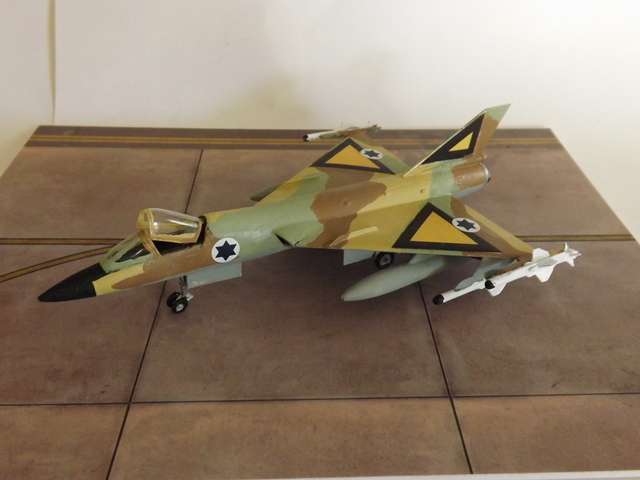
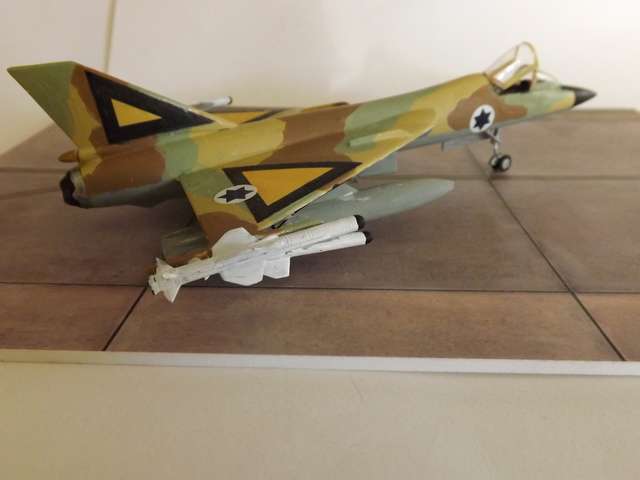
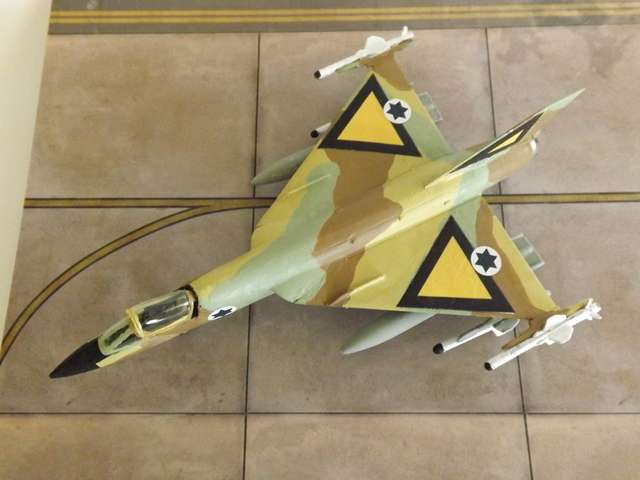
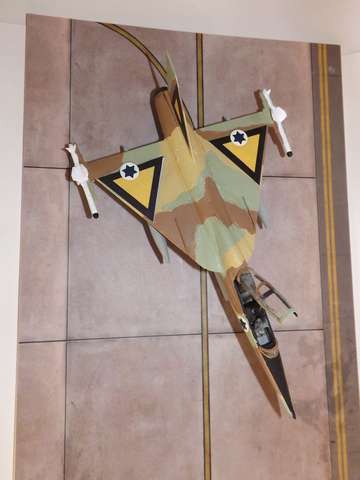
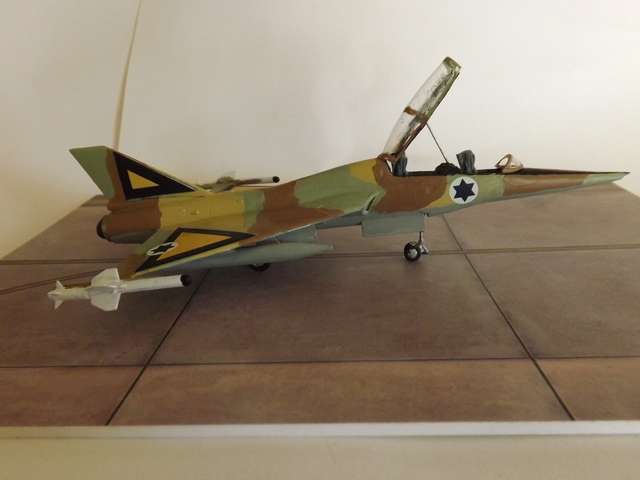
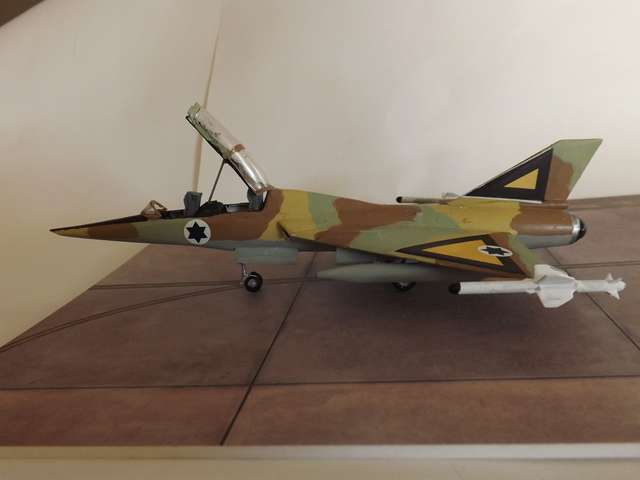
The Models
Both models are converted Novo Fairey Delta II kits.
About 12 months ago, I started work on converting a Eastern Express version of the Frog Mirage III kit into a two seater Mirage using the Falcon vacuform nose. However, it required too much filling for my liking and I basically abandoned it. It sat on the corner of my modelling desk ever since, looking forlornly at me.
I had the idea of using the FD II kit as a production aircraft and then I thought who would the British sell it to. Ah, ha! I thought, Israel! So I then started thinking about what was required to make it into a production fighter. Mmm, a radar would be necessary. Now, where to get a radar nose? Ah, ha! I had the spare nose from the EE Mirage III kit. So, I checked in the box and yes, there it was. So, after carefully removing the entire nose section of the Delta, I glued the nose from the aborted Mirage in it's place and it fit perfectly. Excellent.
Now, I had another FD II kit, which I'd bought off EvilBay which was partly constructed. My mind was thinking, how about the two seater Mirage nose? So, out came the razor saw and off it came (and off came the intakes from it's sides as well). Yes, it was a good fit but I needed to replace the sides to the fuselage where the intakes had been. Not too hard at all. So, now I had two FD IIs. A fighter and the second a trainer. I used the Mirage III's drop tanks on both kits and used up my horde of Red Top missiles. The nose wheel was a bit high on both kits so I cut that down on the two seater. The single seater ended up with the noseleg from the Mirage. What both are lacking is a gun. Oh, well, that fits with the mentality of the period that missiles are an assured kill...
Knowing that the Israelis operated in real life, Mirages, I had Kit print up some yellow triangles designed to fit the FD's wings and tail and they came up a treat, as you can see. The Israeli Star of Davids are from another aftermarket sheet I have.
The Fairey Delta 2 or FD2 (internal designation Type V within Fairey) was a British supersonic research aircraft produced by the Fairey Aviation Company in response to a specification from the Ministry of Supply for a specialised aircraft for conducting investigations into flight and control at transonic and supersonic speeds. Key features of the type include the adoption of a delta wing and a droop-nose. On 6 October 1954, the Delta 2 conducted its maiden flight, flown by Fairey test pilot Peter Twiss.
The Fairey Delta 2 holds the distinction of being the first jet aircraft to exceed 1000 mph in level flight, flying faster than the sun moves across the sky. On 10 March 1956, it set a new world speed record of 1,132 mph during a test flight. The Delta 2 held the absolute World Air Speed Record for over a year. It continued to be used for test flights, and was allocated to the Royal Aircraft Establishment (RAE) in 1958.
To satisfy a requirement for a testbed aircraft for the in-development "ogee delta" wing design, one of the Delta 2 aircraft was extensively rebuilt to become the BAC 221. On 1 May 1964, the modified aircraft performed its first flight. As a result of flight testing conducted by the 221, the ogee delta wing was subsequently adopted for the Concorde supersonic transport airliner. The FD2 was also used as the basis for Fairey's submissions to the Ministry for advanced all weather interceptor designs, culminating in the proposed Fairey Delta III to meet the F.155 specification.
In 1959, Fairey and Dassault entered into an agreement to co-produce the Delta II as a fighter aircraft. Combining Dassault's knowledge of combat aircraft and Fairey's knowledge of high speed aerodynamics, they proposed the Delta II to NATO as part of it's competition to find a common fighter-bomber aircraft. Fighting off the US competitor, the F-104 proved difficult but when some smart detective work by the French detective Monsieur Clouseau showed that Lockheed was not above paying massive bribes to Government officials of NATO countries to secure the contract, the scandal that erupted ensured that the Fairey Delta II found it's place in the armouries of the world.
Equipped with a redesigned nose to carry a large radar scanner and carrying four British IR guided missiles (initially Firestreaks but later Red Tops), and underwing hard points for the carriage of external fuel tanks and/or bombs, the Fairey/Dassault Delta fighter bomber proved a large success, equipping the air forces of Holland, Belgium, Norway, West German and Italy, as well as other nations, including Australia, South Africa and Israel.
As already related, the British became the main supplier of Israeli defence equipment after the 1956 Suez Crisis saw the end of the Nasser regime in Cairo. While the Israelis were wary of their new found liberation from direct threat from the Arab nations which surrounded their tiny country, they decided that the cornerstone of their freedom was their Air Force. It was therefore an easy decision to decide to adopt the Fairey/Dassault Delta II Fighter-Bomber in 1962. It's high speed and superb aerodynamic performance ensured that the Israelis were the superiors of their neighbours. When the Arabs followed suit and purchased their own Dassault Delta aircraft, the Israelis introduced their distinctive yellow triangle markings, to prevent a “blue-on-blue” incident occurring.






The Models
Both models are converted Novo Fairey Delta II kits.
About 12 months ago, I started work on converting a Eastern Express version of the Frog Mirage III kit into a two seater Mirage using the Falcon vacuform nose. However, it required too much filling for my liking and I basically abandoned it. It sat on the corner of my modelling desk ever since, looking forlornly at me.
I had the idea of using the FD II kit as a production aircraft and then I thought who would the British sell it to. Ah, ha! I thought, Israel! So I then started thinking about what was required to make it into a production fighter. Mmm, a radar would be necessary. Now, where to get a radar nose? Ah, ha! I had the spare nose from the EE Mirage III kit. So, I checked in the box and yes, there it was. So, after carefully removing the entire nose section of the Delta, I glued the nose from the aborted Mirage in it's place and it fit perfectly. Excellent.
Now, I had another FD II kit, which I'd bought off EvilBay which was partly constructed. My mind was thinking, how about the two seater Mirage nose? So, out came the razor saw and off it came (and off came the intakes from it's sides as well). Yes, it was a good fit but I needed to replace the sides to the fuselage where the intakes had been. Not too hard at all. So, now I had two FD IIs. A fighter and the second a trainer. I used the Mirage III's drop tanks on both kits and used up my horde of Red Top missiles. The nose wheel was a bit high on both kits so I cut that down on the two seater. The single seater ended up with the noseleg from the Mirage. What both are lacking is a gun. Oh, well, that fits with the mentality of the period that missiles are an assured kill...
Knowing that the Israelis operated in real life, Mirages, I had Kit print up some yellow triangles designed to fit the FD's wings and tail and they came up a treat, as you can see. The Israeli Star of Davids are from another aftermarket sheet I have.
Share: